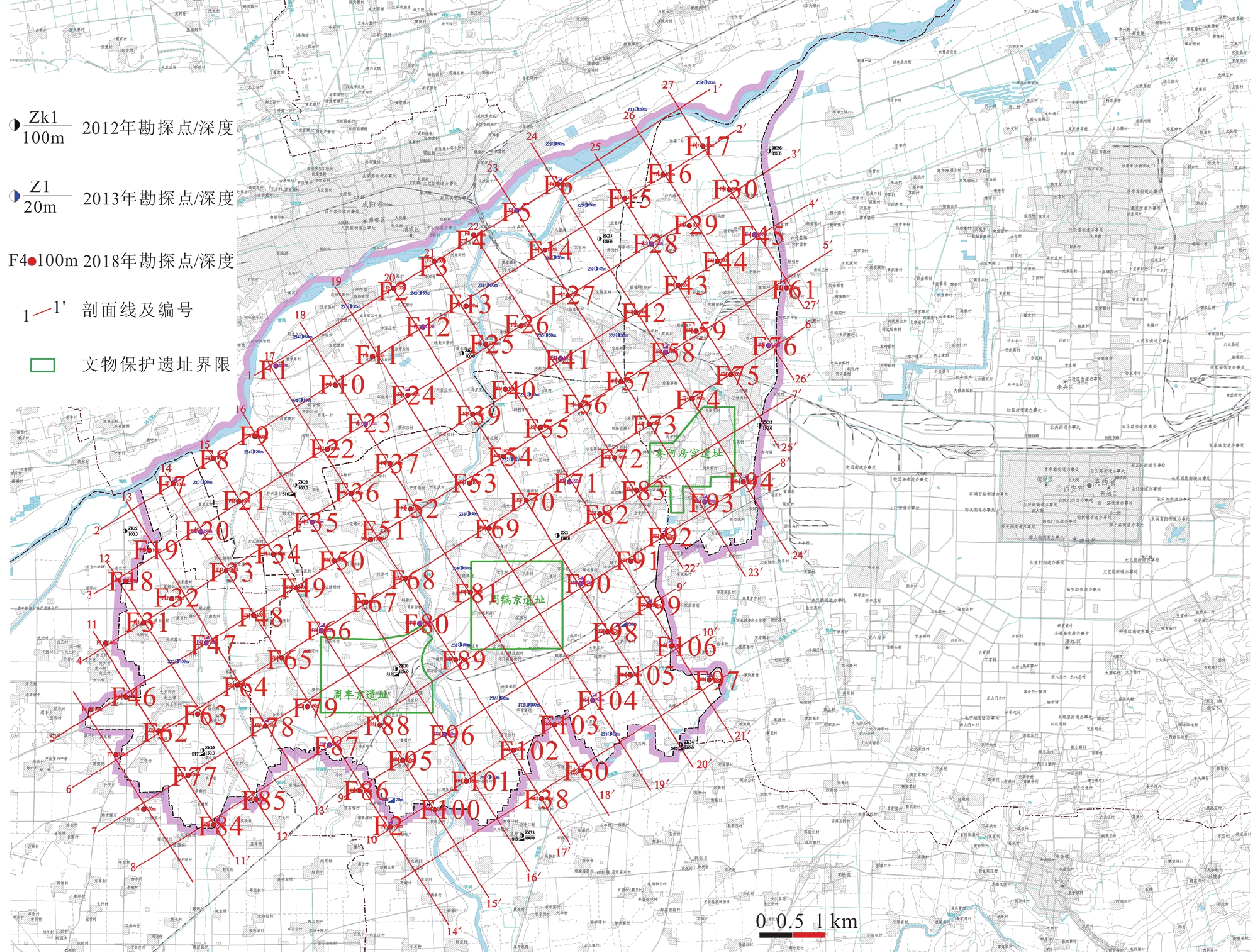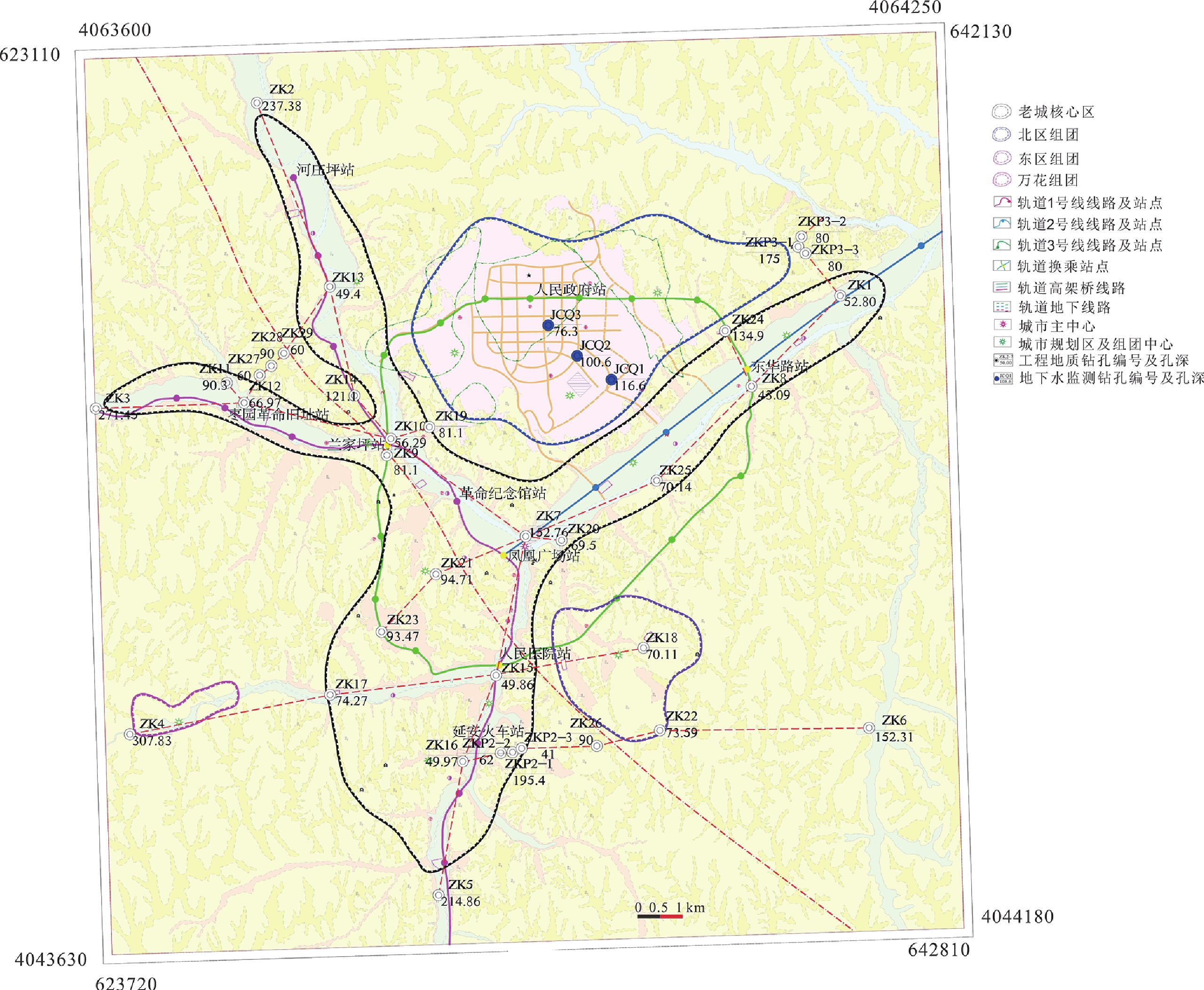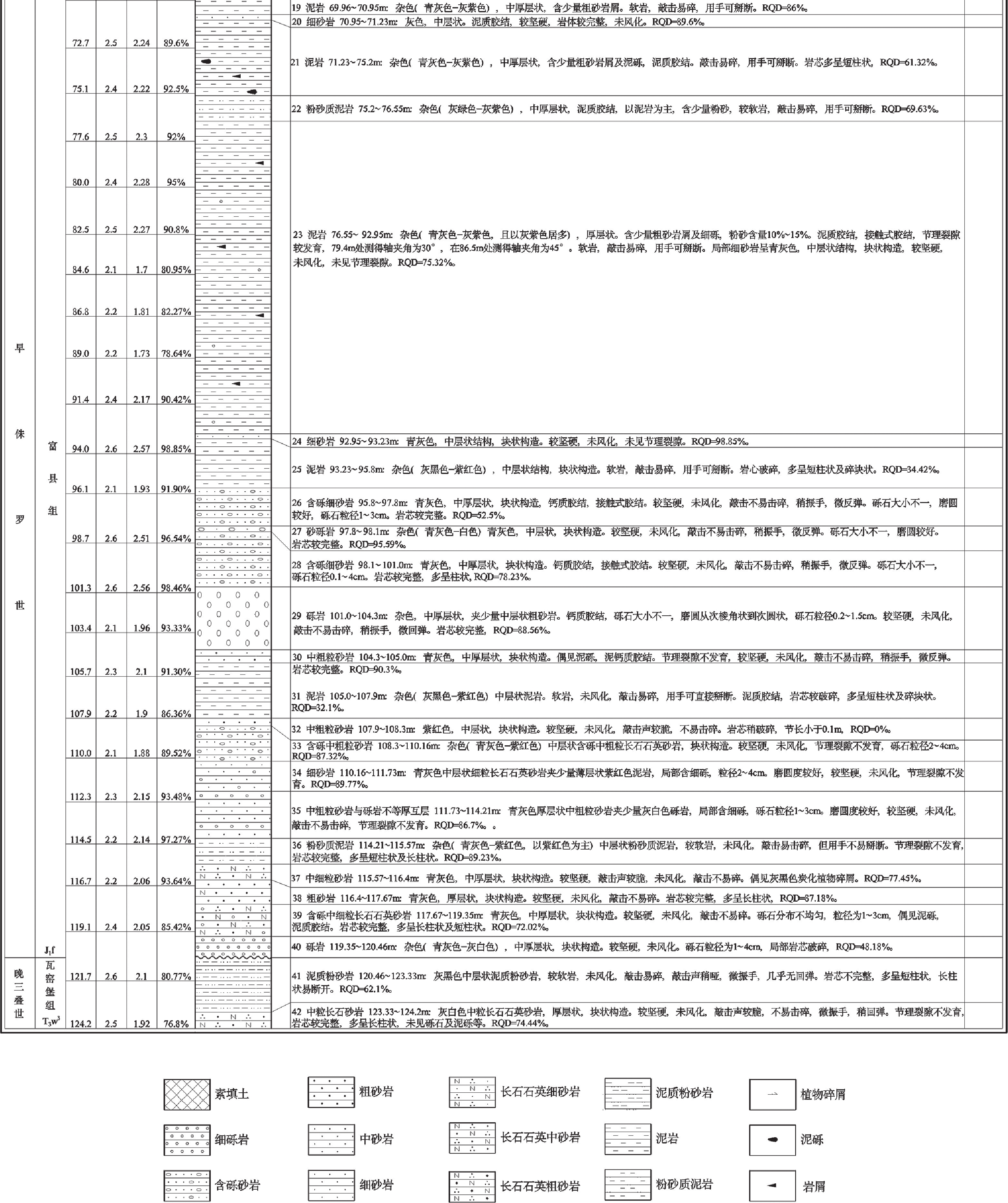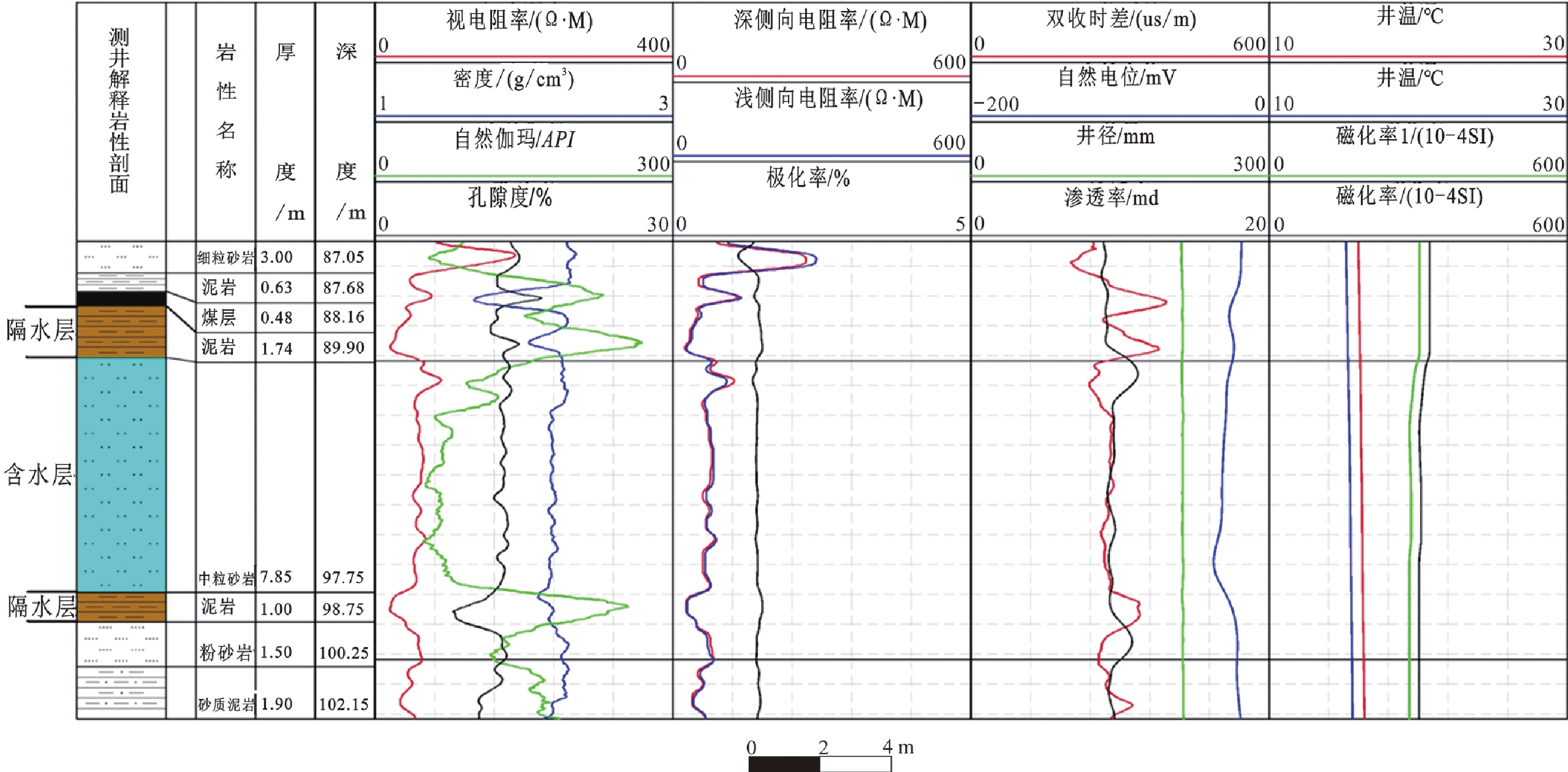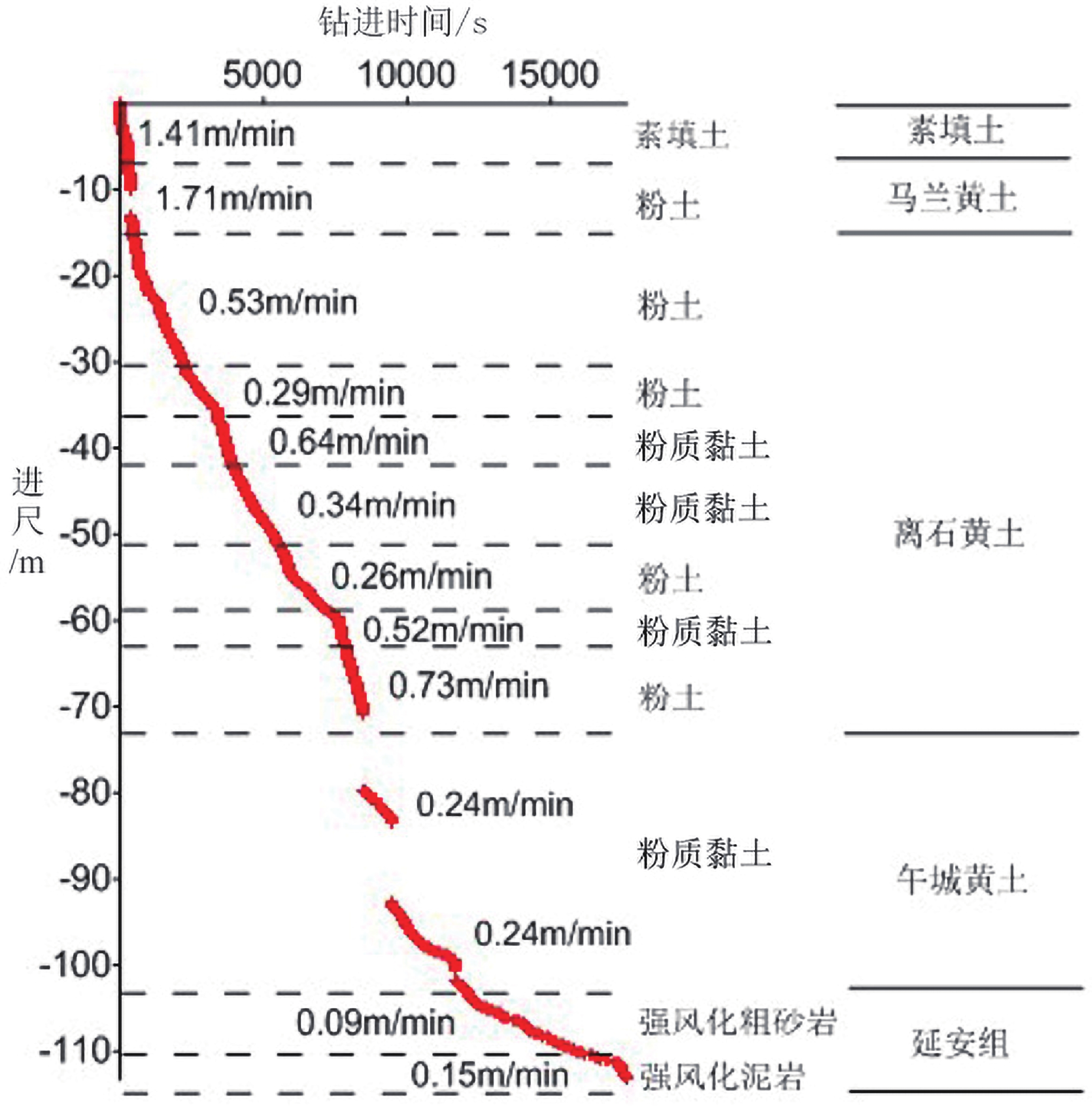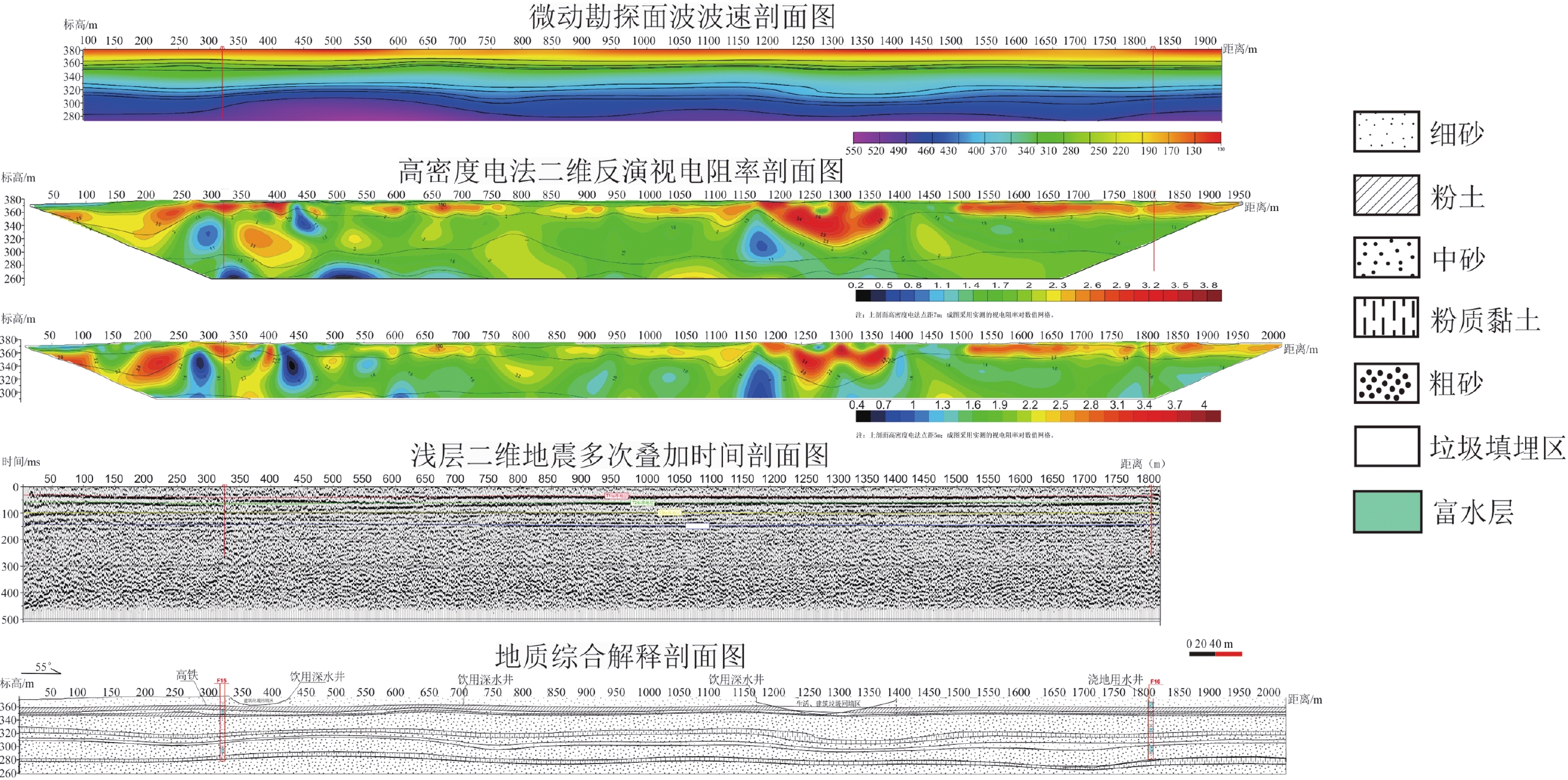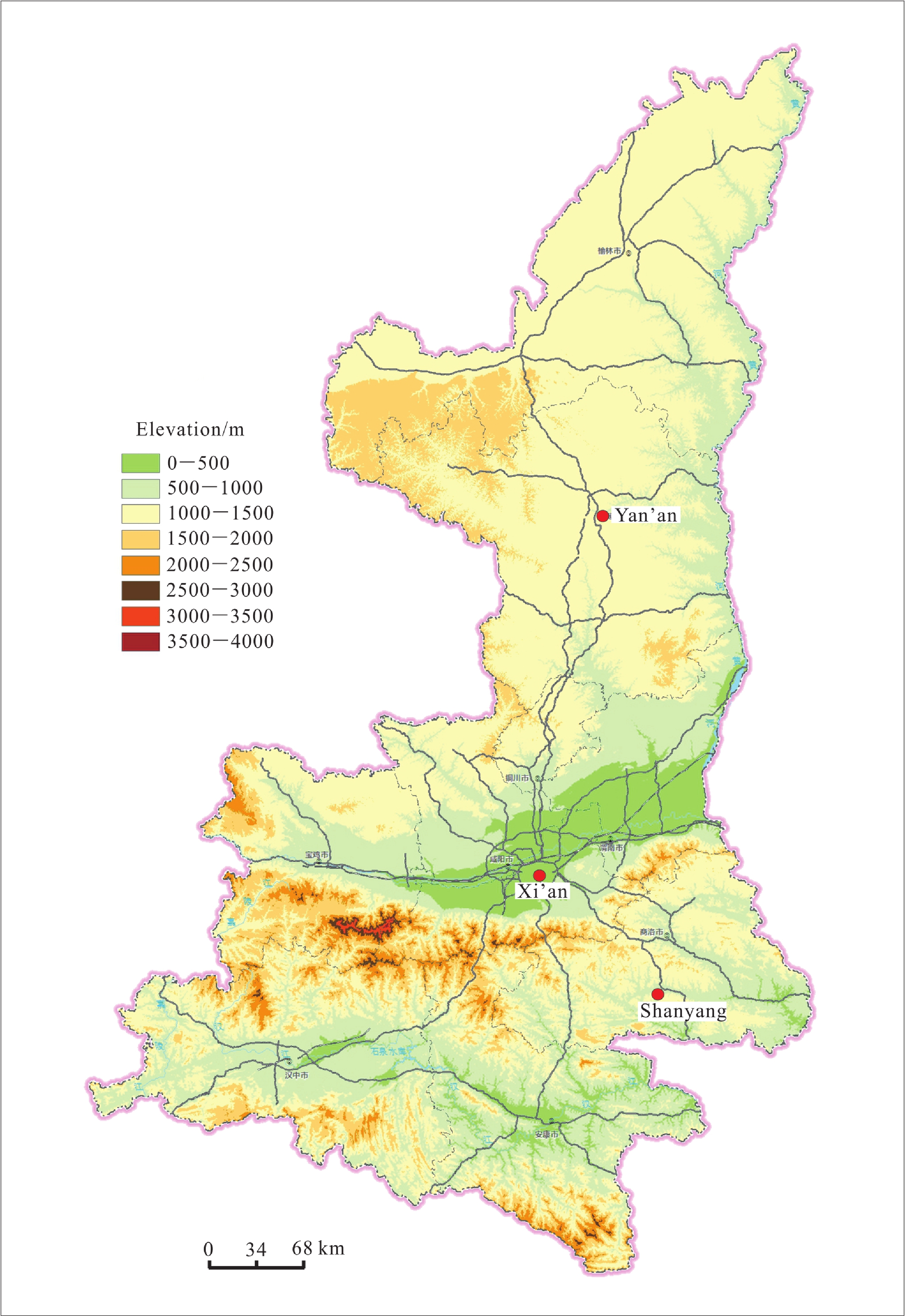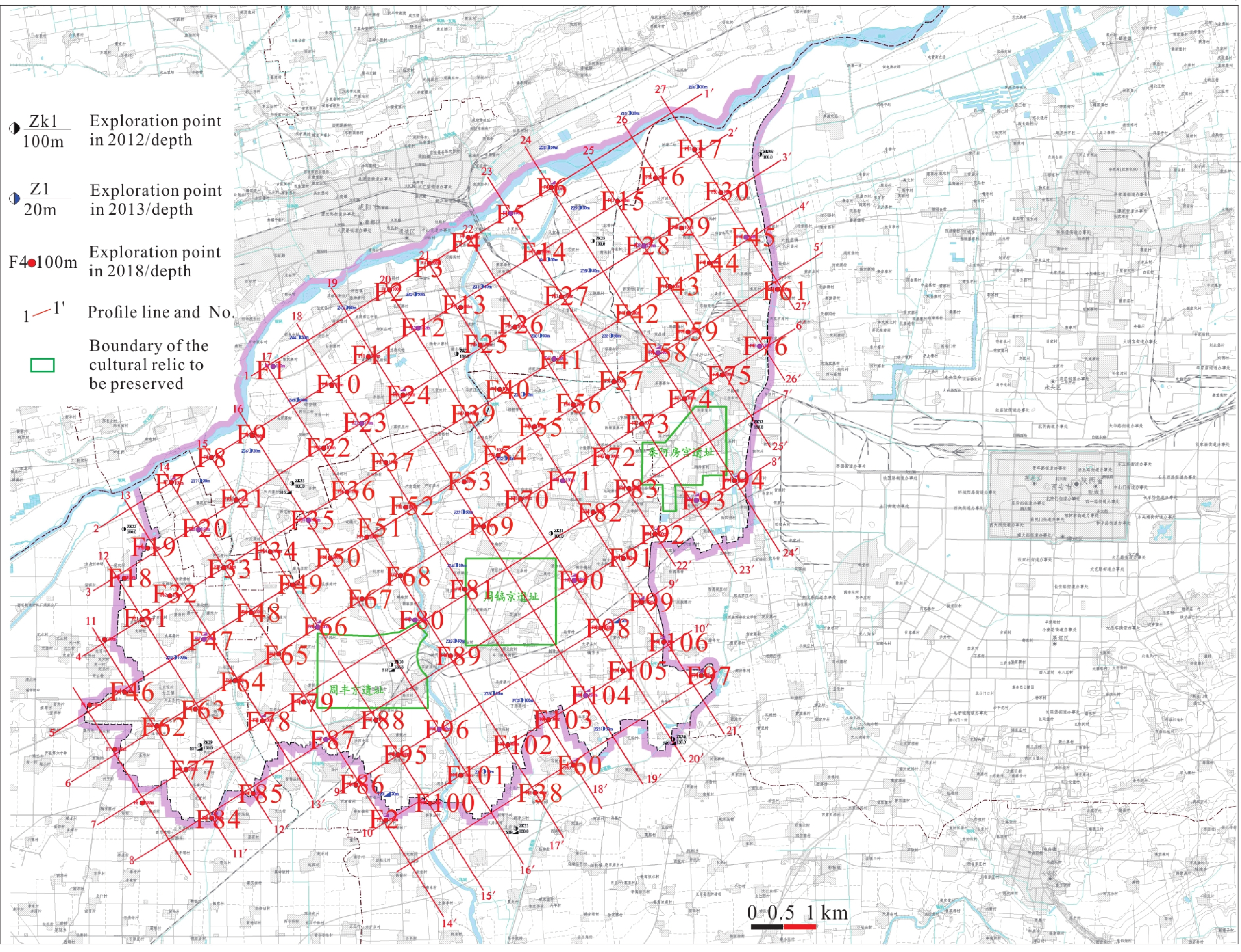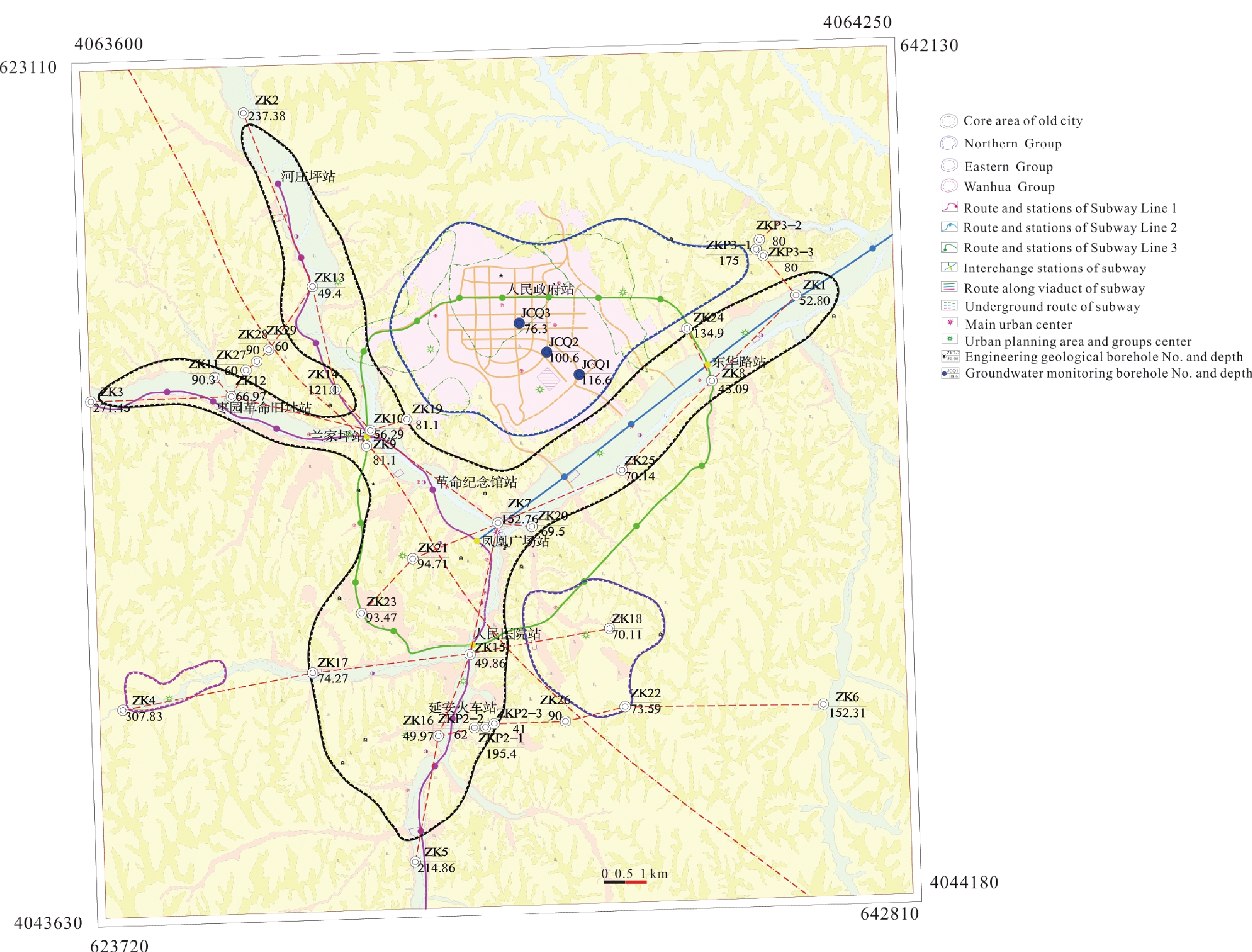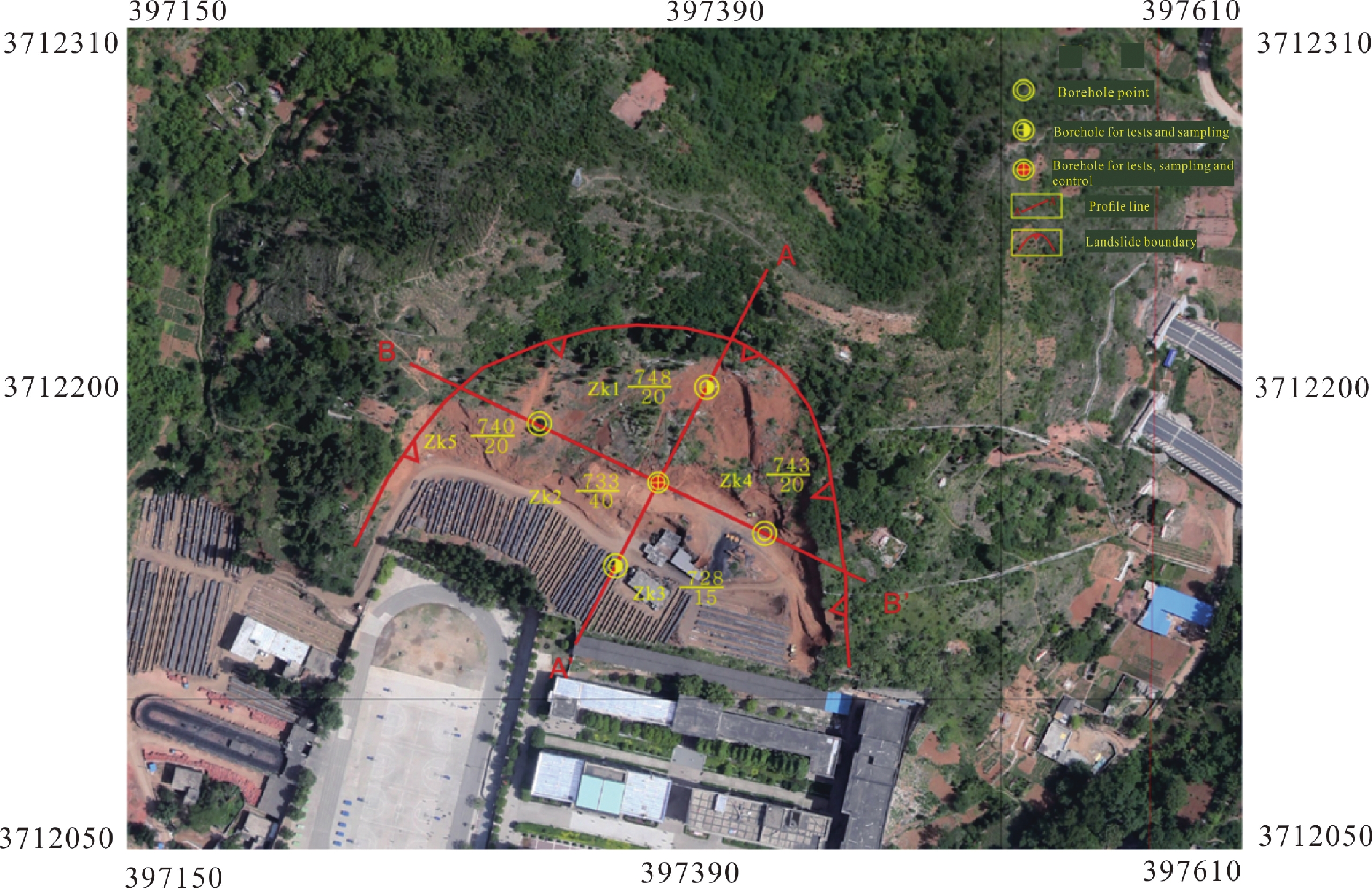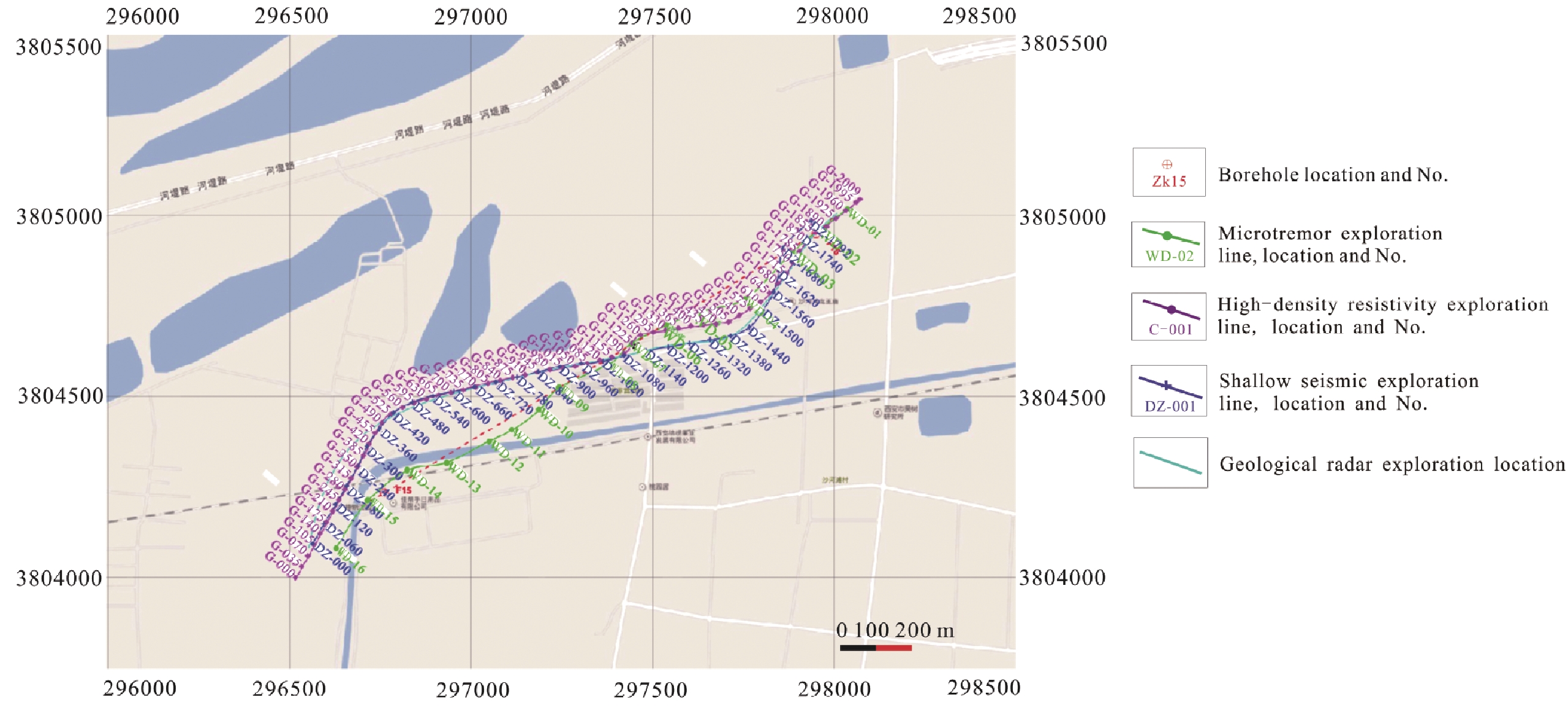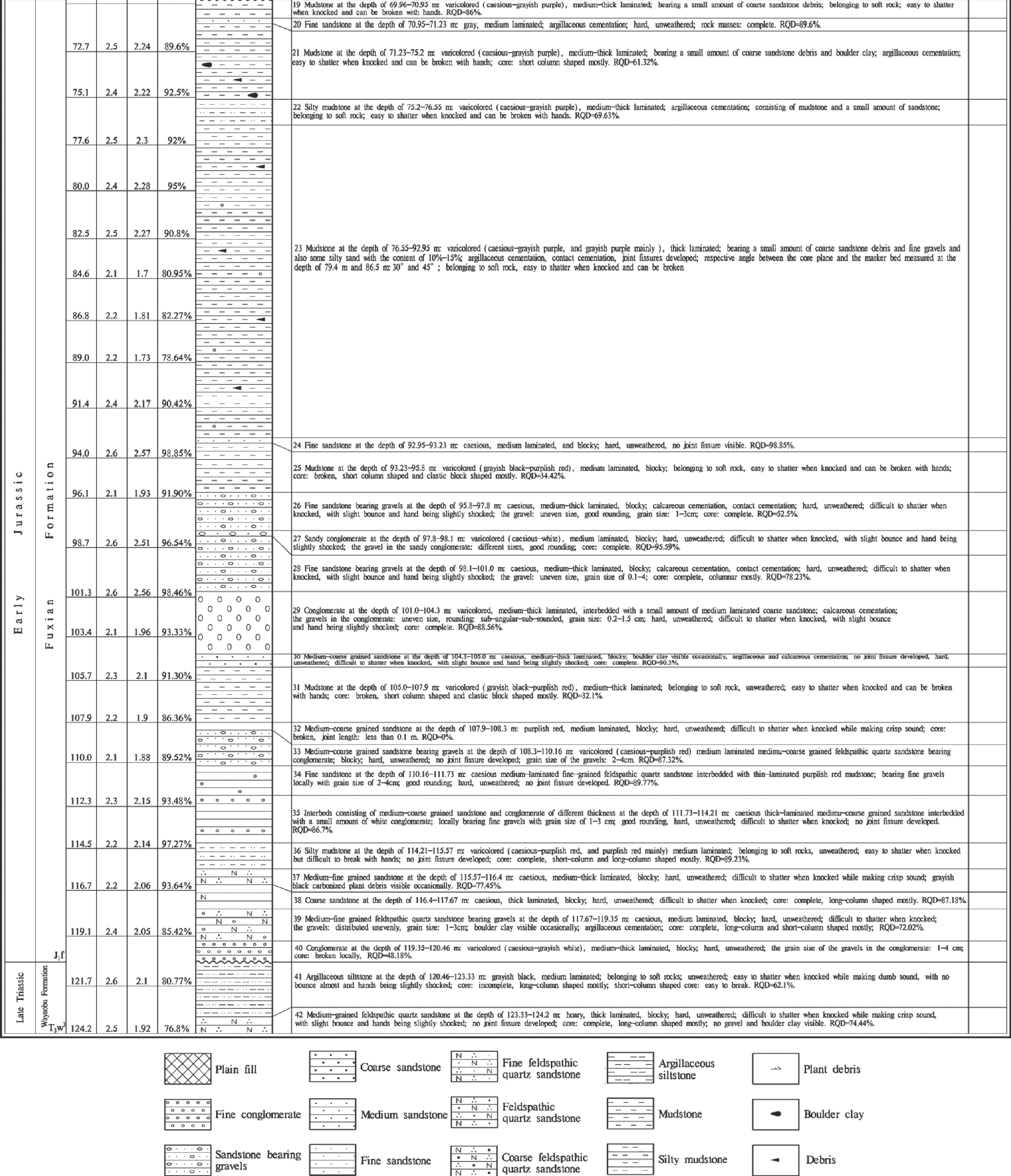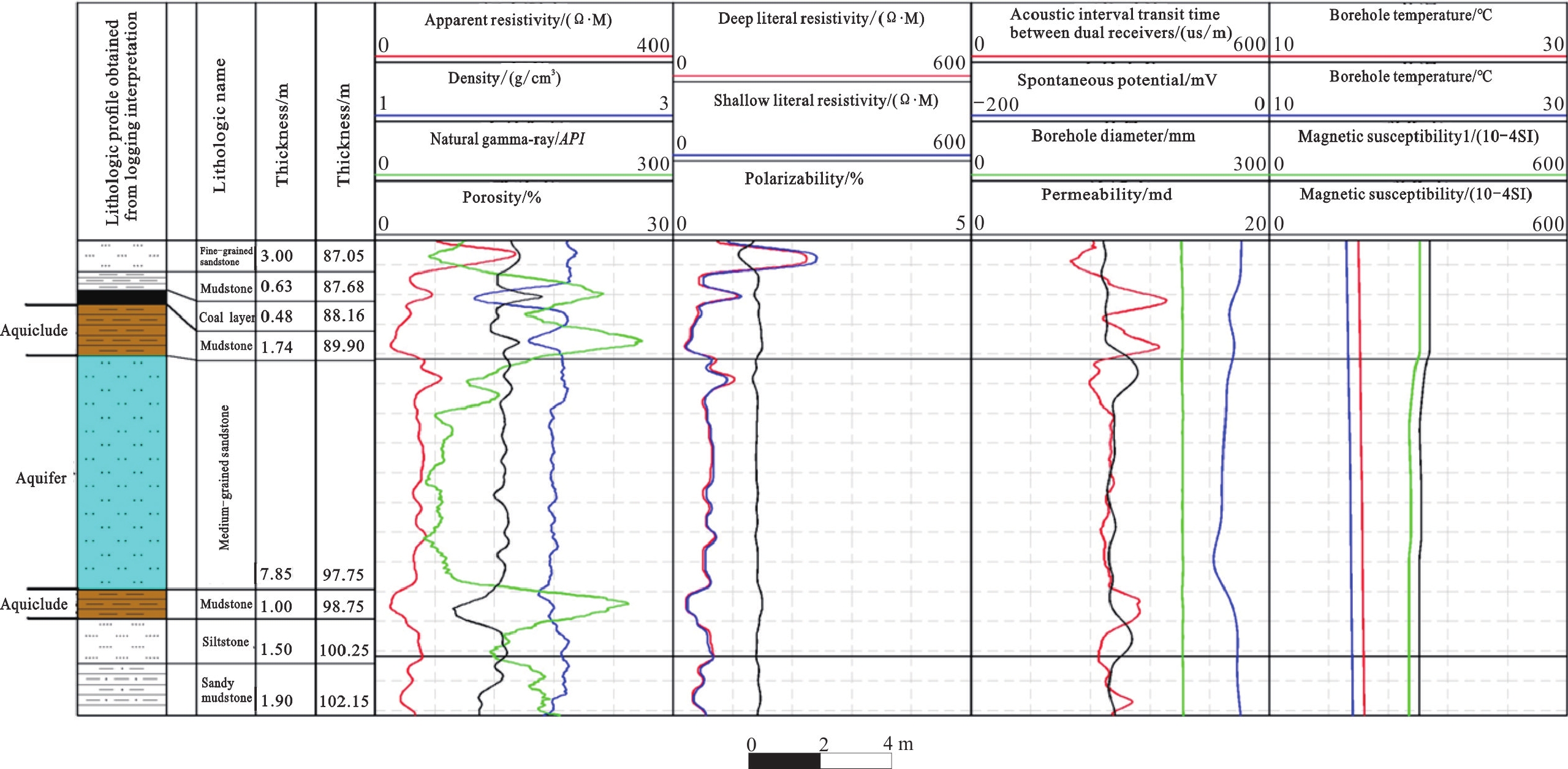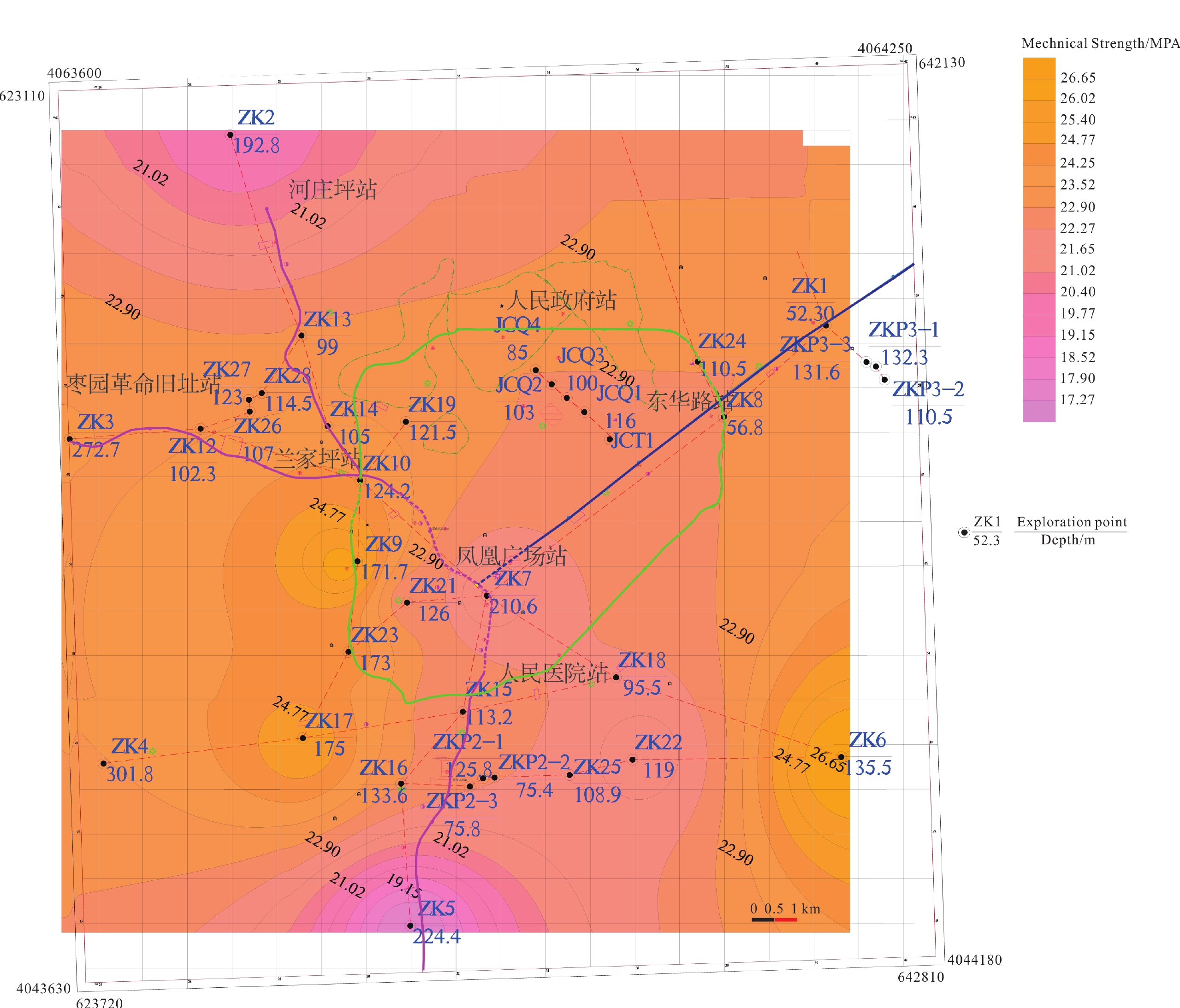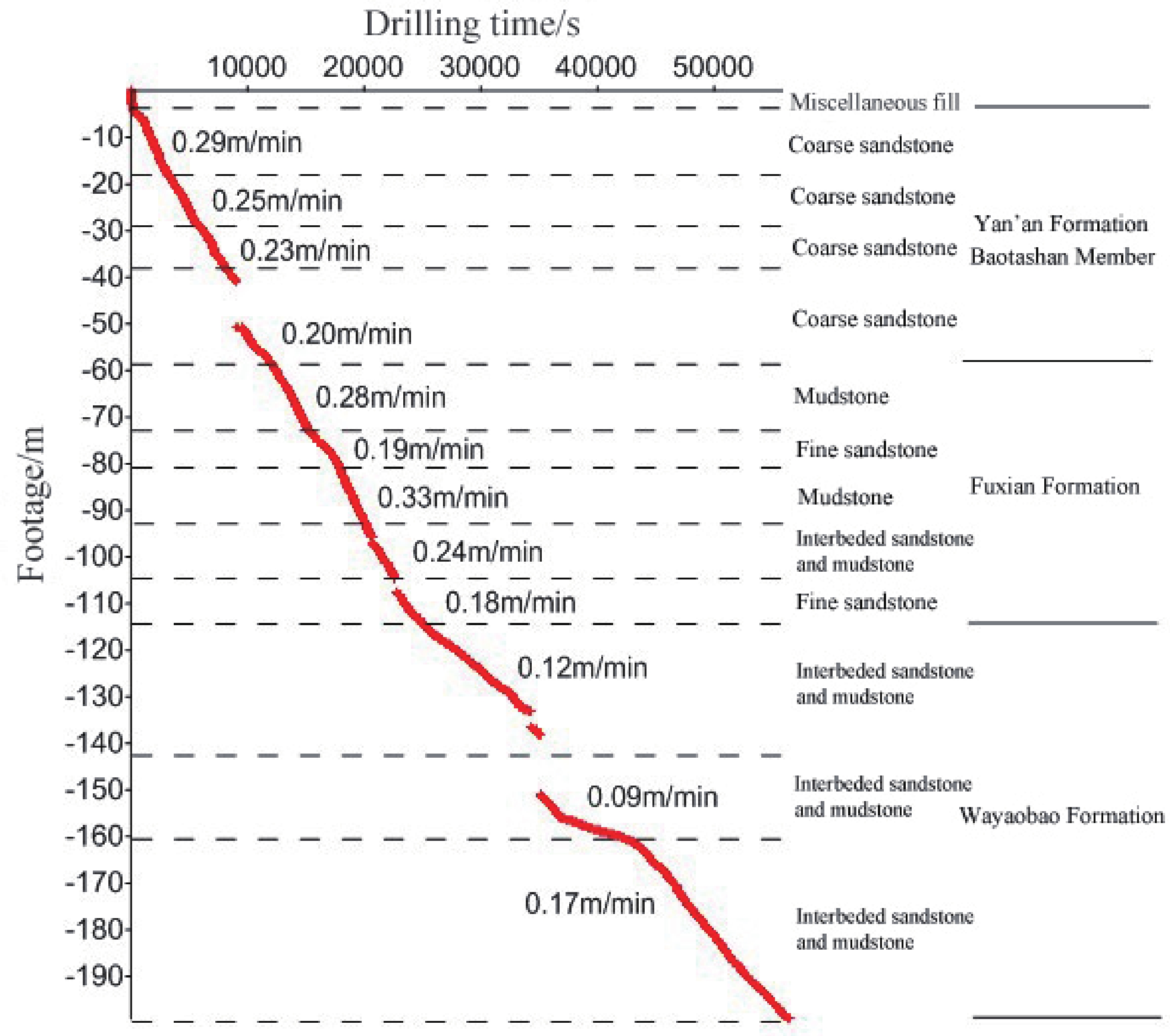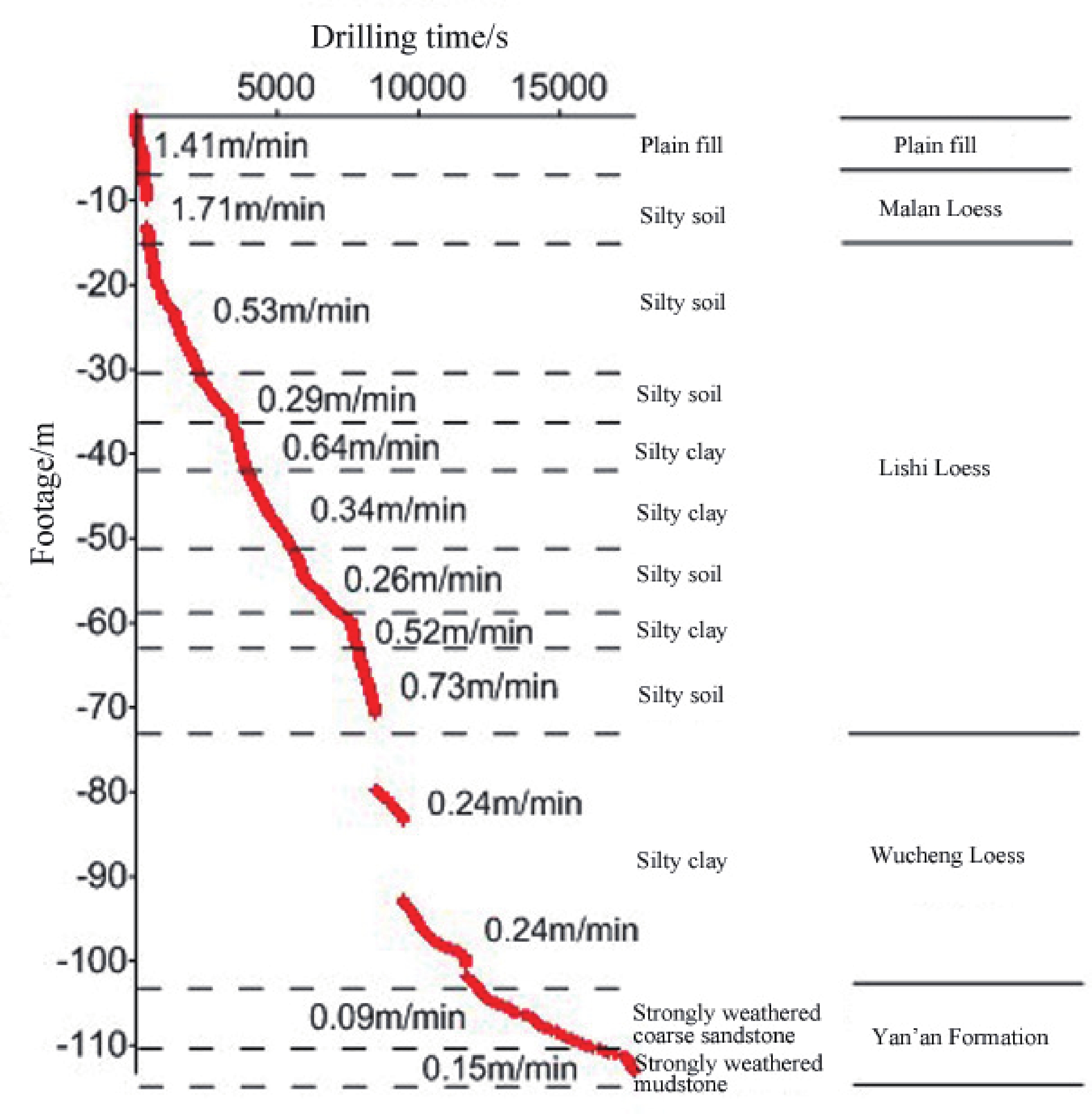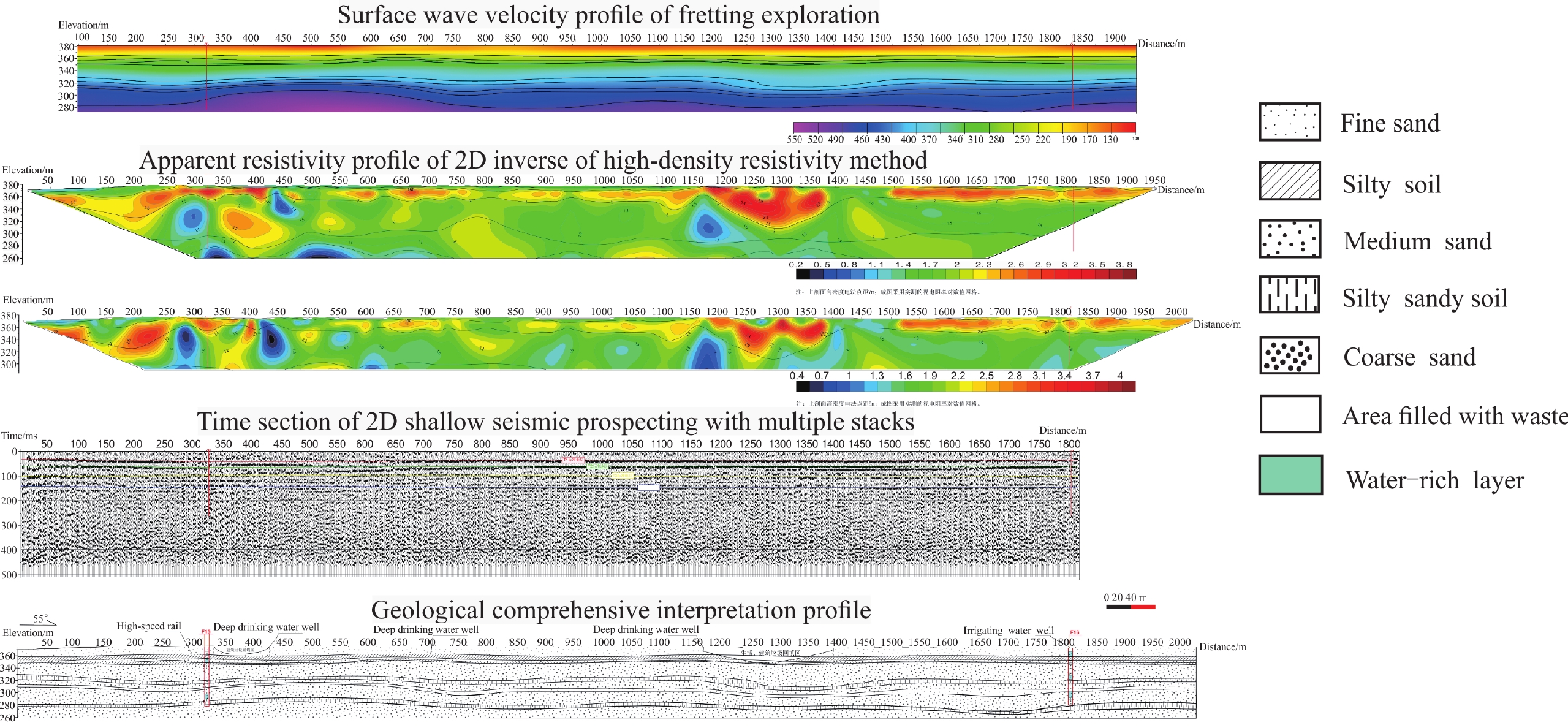All-Element Dataset of Combined Exploration of Urban Underground Spaces with Strong Interference
-
摘要:
地下空间利用已成为解决城市发展空间问题的主要途径,地下空间精准探测是地下空间资源开发利用的基础,但城市强干扰环境下地下空间探测的原理、方法组合、采集的要素及数据应用等目前尚为难题。本数据集依托中国地质调查局陕西省重要城镇地质灾害风险评估(2013—2016)、关中-天水经济区综合地质调查(2016—2018)、西安多要素城市地质调查(2018—2021)、延安革命老区综合地质调查(2018—2021) 4个项目,面向岩土体质量评价和城市地下空间资源评价与开发利用的需要,在常规物探、钻探和实验测试基础上,引入了随钻监测技术,开展了13个参数的测井,形成了地下空间组合探测方法,获取了岩土体质量和城市地下空间评价所需的全要素数据。本数据集分别来自陕西省秦巴山地山阳县城区、关中盆地西安市城区和黄土高原延安市城区,数据包含工程地质钻探、实验测试、多参数测井、随钻监测和地面物探5种数据类型,其中工程地质钻孔144个,实验测试样品672个,物探测井13类参数111个孔,随钻监测36个孔,地面物探4类方法5条剖面,共计968组数据,3 664个文件,格式包含jpg,xls,doc,mpj,dwg。该数据集可用于岩土体质量评价、城市三维地质全要素建模、地下空间资源评价、岩土体质量与物性参数耦合关系研究,以及城市地质科学研究。
Abstract:The utilization of underground space has become a major means of solving the problems plaguing cities, and the precise exploration of underground space is fundamental to its development and utilization. However, the theories, method combination, elements to be acquired and data application regarding the exploration of urban underground space with strong interference are yet to be determined in a united manner. The all-element dataset of combined exploration of urban underground space with strong interference (also referred to as the Dataset) relies on these four projects initiated by the China Geological Survey: Risk Assessment of Geologic Disasters in Important Towns in Shaanxi Province (2013—2016), Comprehensive Geological Survey in Guanzhong – Tianshui Economic Region (2016—2018), Multi-element Urban Geological Survey in Xi’an (2018—2021) and Comprehensive Geological Survey in Yan’an, a Former Base of the Communist Party of China (2018—2021). The aim of these projects were to meet the demand for quality assessment of rock and soil masses and also the assessment, development and utilization of urban underground space. During the development of the Dataset, monitoring-while-drilling (MWD) technology was introduced based on regular geophysical prospecting, drilling and testing. Furthermore, a total of 13 parameters was logged, a combined method of underground space exploration was established and the all-element data required for quality assessment of rock and soil masses and urban underground space were obtained. The data in the Dataset were obtained from the urban area of Shanyang County, in the Qinba Mountains of Shaanxi Province, the urban area of Xi’an City in the Guangzhong Basin and the urban area of Yan’an City in the Loess Plateau. It consists of five types of data, i.e., engineering geological drilling, testing, multi-parameter logging, MWD and ground geophysical prospecting. In detail, the data were acquired from 144 engineering geological boreholes, 672 testing samples, 111 boreholes for the logging of 13 parameters by geophysical prospecting, 36 MWD boreholes and 5 profiles of ground geophysical prospecting obtained via 4 methods. In total, the Dataset consists of 968 sets of data and 3 664 files in the formats of .jpg, .xls, .doc, .mpj and .dwg. It can be applied to the quality assessment of rock and soil masses, the establishment of 3D urban geological all-element models, the assessment of underground space resources, the research on the coupling relationship between the quality and physical properties of rock and soil masses and the scientific research of urban geology.
-
1. 引言
遥感地质找矿是遥感信息获取、含矿信息提取以及含矿信息成矿分析与应用的过程, 近年来, 被广泛应用于地质、矿产资源及相关环境的调查中(刘燕君等, 1993; 朱振海, 1994; 郭德方, 1995; Sabins, 1999; Everett et al., 2002; 廖崇高等, 2002; 连长云等, 2005; 刘颖璠等, 2012; 钱建平等, 2012; 谭克龙等, 2012; 杜小弟等, 2015)。航空高光谱是当前遥感的前沿技术, 通过高光谱成像所获取的地球表面的图像包含光谱维信息融合为一体, 即“图谱合一” (束炯等, 2006), 具有波段数多, 波带窄, 对地物能定量分析等优点, 是20世纪末期以来遥感领域最大的技术进展(Campbell et al., 2011)。航空高光谱遥感技术相对于星载高光谱遥感技术, 可以获取高空间分辨率的高光谱遥感数据, 因而对微小地物具有更强的识别能力(刘德长等, 2015)。通过高光谱矿物填图, 可以大面积、快速提取蚀变矿物(Clack et al., 1990)。王润生等(2010)系统总结了高光谱矿物填图技术流程、工作方法和技术体系。中国国土资源航空物探遥感中心在新疆土屋东—三岔口地区, 应用HyMap航空成像光谱数据填绘出了白云母、绿泥石、绿帘石、绿泥石和绿帘石组合、高岭石、蒙脱石、透辉石、透闪石、蛇纹石、褐铁矿、方解石等矿物或矿物组合种类(王润生等, 2011)。
本文以新疆卡拉塔格地区获取的HyMap航空高光谱数据、地面准同步定标数据、地面高光谱数据为例, 提取并筛选了基于HyMap航空高光谱影像的成矿有利蚀变信息, 在此基础上对红山铜金矿床航空-地面高光谱提取的蚀变信息进行了综合剖析, 并结合矿区地质背景, 建立了红山铜金矿床高光谱遥感地空综合找矿模型, 圈定了2处找矿有利地段。
2. 研究区地质概况
研究区大地构造位于东天山吐哈盆地南缘、大南湖—头苏泉晚古生代岛弧带(图 1)。
![]() 图 1 新疆卡拉塔格地区地质矿产图1—全新统:砂石及砾石沉积; 2—下侏罗统三工河组:粉砂质泥岩、泥质砂岩夹钙质砂岩; 3—上二叠统库莱组:砾岩、中粗粒岩屑砂岩; 4—中二叠统阿尔巴萨依组:凝灰岩、橄榄玄武岩; 5—上石炭统脐山组:玄武岩、安山岩; 6—下泥盆统大南湖组:安山岩、英安岩、熔结凝灰岩、火山角砾岩; 7—中—上志留统红柳峡组:凝灰质砾岩、晶屑岩屑凝灰岩; 8—中奥陶统荒草坡群大柳沟组:玄武岩、安山岩、英安岩; 9—志留纪二长花岗岩; 10—志留纪花岗闪长岩; 11—志留纪英云闪长岩; 12—花岗岩体; 13—地质界线; 14—角度不整合界线; 15—岩相界线; 16—逆断层; 17—性质不明断层; 18—推测断层; 19—铜金矿; 20—铜锌矿; 21—铜锌金矿; 22—铜铁矿Figure 1. Geological map of Kalatag area in Xinjiang1-Holocene, sand and gravel deposits; 2-Lower Jurassic Sangonghe Formation: river silty mudstone, argillaceous sandstone intercalated with calcareous sandstone; 3-Permian Kulai Formation: breccia, coarse grained lithic sandstone; 4-Middle Permian Aebasayi Formation: tuff, olivine basalt; 5-Carboniferous Qishan Formation: basalt, andesite; 6-Lower Devonian Dananhu Formation: andesite, dacite, welded tuff and volcanic breccia; 7-Middle-upper Silurian Hongliuxia Formation: tuffaceous conglomerate, wafer crumbs debris tuff; 8-Daliugou Formation of Ordovician Huangcaopo Group: basalt, andesite, dacite; 9-Silurian monzonitic granite; 10-Silurian granite diorite; 11-Silurian tonalite; 12-Granite rock mass; 13-Geological boundary; 14-Angular unconformity; 15-Petrofacies boundary; 16-Thrust; 17-Unknown fault; 18-Inferred fault; 19-Copper and gold deposit; 20-Copper and zinc deposit; 21-Copper zinc deposit; 22-copper deposit
图 1 新疆卡拉塔格地区地质矿产图1—全新统:砂石及砾石沉积; 2—下侏罗统三工河组:粉砂质泥岩、泥质砂岩夹钙质砂岩; 3—上二叠统库莱组:砾岩、中粗粒岩屑砂岩; 4—中二叠统阿尔巴萨依组:凝灰岩、橄榄玄武岩; 5—上石炭统脐山组:玄武岩、安山岩; 6—下泥盆统大南湖组:安山岩、英安岩、熔结凝灰岩、火山角砾岩; 7—中—上志留统红柳峡组:凝灰质砾岩、晶屑岩屑凝灰岩; 8—中奥陶统荒草坡群大柳沟组:玄武岩、安山岩、英安岩; 9—志留纪二长花岗岩; 10—志留纪花岗闪长岩; 11—志留纪英云闪长岩; 12—花岗岩体; 13—地质界线; 14—角度不整合界线; 15—岩相界线; 16—逆断层; 17—性质不明断层; 18—推测断层; 19—铜金矿; 20—铜锌矿; 21—铜锌金矿; 22—铜铁矿Figure 1. Geological map of Kalatag area in Xinjiang1-Holocene, sand and gravel deposits; 2-Lower Jurassic Sangonghe Formation: river silty mudstone, argillaceous sandstone intercalated with calcareous sandstone; 3-Permian Kulai Formation: breccia, coarse grained lithic sandstone; 4-Middle Permian Aebasayi Formation: tuff, olivine basalt; 5-Carboniferous Qishan Formation: basalt, andesite; 6-Lower Devonian Dananhu Formation: andesite, dacite, welded tuff and volcanic breccia; 7-Middle-upper Silurian Hongliuxia Formation: tuffaceous conglomerate, wafer crumbs debris tuff; 8-Daliugou Formation of Ordovician Huangcaopo Group: basalt, andesite, dacite; 9-Silurian monzonitic granite; 10-Silurian granite diorite; 11-Silurian tonalite; 12-Granite rock mass; 13-Geological boundary; 14-Angular unconformity; 15-Petrofacies boundary; 16-Thrust; 17-Unknown fault; 18-Inferred fault; 19-Copper and gold deposit; 20-Copper and zinc deposit; 21-Copper zinc deposit; 22-copper deposit区内地层整体呈北西向产出, 由中奥陶统荒草坡群大柳沟组(O2Hd)、中—上志留统红柳峡组(S2-3h)、下泥盆统大南湖组(D1d)、上石炭统脐山组(C2qs)、中二叠统阿尔巴萨依组(P2a)、上二叠统库莱组(P3k)、下侏罗统三工河组(J1s)、全新统(Qh)组成。
该区经历了多期次的构造变动, 区域构造形成类型多样、特征复杂, 褶皱、断裂和火山机构发育, 区域性的断裂构造控制着该区火山岩和侵入岩的展布, 次级断裂控制着矿化蚀变带的分布, 更次一级构造裂隙带控制着矿化体的产出。主要发育北西、北北西和北东东向三组断裂构造, 其中北西向断裂为该区主要控矿构造, 同火山断裂发育, 含矿火山热液沿断裂活动强烈。
区内火山活动强烈, 火山岩分布广泛。岩石类型以中基性火山岩为主, 中酸性火山岩次之, 从奥陶系至二叠系均有出露, 其中奥陶系最为发育, 其次为泥盆系、石炭系, 二叠系局部出现。侵入岩较为发育, 主要为一套古生代侵入体, 包括中酸性闪长岩、花岗闪长岩、花岗岩等侵入岩, 中部为与铜金矿化直接相关的中生代中酸性火山机构, 主要由石英斑岩、钠长斑岩、英安岩、英安斑岩、安山玢岩、闪长玢岩和火山角砾集块岩等岩性构成。其中志留纪侵入岩由老到新依次为英云闪长岩、花岗闪长岩、二长花岗岩、花岗斑岩。该区经受了区域埋深变质作用, 变质程度较弱, 主要变质矿物为绿泥石、钠长石、葡萄石、石英、阳起石、方解石、绿帘石。
区内已知矿床自北西向南东依次产出有:红山铜金矿床→梅岭铜锌金矿床→红石铜金矿床→红海铜锌金矿床。
3. 高光谱遥感地空综合预测方法用于寻找铜金矿床的原理
3.1 高光谱遥感地空综合预测方法的依据
不同矿床类型由于岩石岩性和蚀变矿物不同, 它们的光谱特征有明显的差异(姚佛军, 2006)。铜金矿床属于内生金属矿床, 这类矿床与地表蚀变密切相关, 可以利用航空高光谱遥感影像进行蚀变矿物提取, 结合地表岩石光谱测试分析, 应用HyMap航空成像光谱仪和美国ASD公司的FieldSpec Pro FR光谱仪对不同类型矿床的光谱特征进行测量, 分析其不同类型矿床的光谱特征, 进行蚀变矿物遥感信息提取, 开展高光谱遥感地空综合预测研究, 进而指导找矿。
3.2 蚀变矿物诊断性光谱特征分析
岩矿的光谱包含有一系列特征吸收谱带。每一个特征谱带或谱带组合与岩矿内部微粒的物质属性存在一定的对应关系(Povarennykh, 1978)。在短波红外光谱区域, 褐铁矿、黄钾铁矾、白云母、绿泥石等具有可以识别的诊断性光谱特征, 特征吸收波段的深度与岩石中这些矿物的含量密切相关(刘圣伟, 2006)。矿物诊断性光谱吸收包括金属阳离子在可见光区域的电子过程以及阴离子基团在近红外区域的振动过程。蚀变矿物的可见光−近红外范围内几种官能团主要包括Fe2+、Fe3+、Al−OH、Mg−OH、OH-、CO32-。
一般阴离子诊断谱带位于2000~2500 nm光谱区域。而Fe2+、Fe3+和Mn2+诊断谱带一般位于400~1200 nm光谱区域(甘甫平等, 2003)。所以根据400~1100 nm光谱区间的Fe吸收谱带和2000~2500 nm羟基和碳酸根谱带将矿物分为含铁矿物、含羟基矿物和含碳酸根矿物以及其他矿物(甘甫平, 2003)。褐铁矿的光谱吸收谷是矿物光谱分析、遥感铁染异常提取常用的波段。其中Fe3+离子的特征吸收谷位主要在600~800 nm, 中心位置在700 nm左右, Fe2+离子的特征吸收谷位主要在900~1500 nm, 中心位置在1200 nm左右; 白云母的诊断性光谱特征是Al−OH键在2180~2230 nm之间的尖锐而深的吸收特征, 以及在2340 nm和2440 nm附近的较弱Al−OH特征, Clark et al.(1990)在高光谱分辨率下, 检测到白云母矿物在2200 nm附近的吸收波段随Al含量的增加向长波方向的移动; 绿泥石的光谱具有Fe−OH和Mg−OH的诊断性吸收特征, 波长位置分别为2235~2255 nm和2320~2360 nm, 这些吸收特征的波长随着绿泥石中铁离子含量的增加而增大。
4. HyMap航空高光谱数据获取及处理
综合考虑仪器参数、成图精度的要求、研究区自然地理、地形起伏、野外工作条件等因素, 进行飞行方案的最优设计(表 1)。将HyMap成像光谱仪搭载在Y−12飞机上, 利用国外引进的HyMap航空高光谱遥感测量系统、地面ASD光谱测量系统。采集高光谱分辨率的HyMap航空高光谱遥感数据、地面准同步的地物光谱定标数据。具体获取过程分为3个步骤:首先对HyMap成像光谱仪进行实验室定标, 保证其性能指标达到项目要求, 以获取优质的高光谱影像数据; 其次进行HyMap仪器的安装和测试, 按照仪器安装规范方法, 将HyMap安装在Y−12飞机上, 保证机下的摄影窗口满足数据获取要求, 按照航空成像光谱数据获取规范进行地面测试; 最后为HyMap航空高光谱数据获取和初步质量检查。
表 1 HyMap航空成像光谱仪主要技术参数Table 1. Main technical parameters of HyMap aviation imaging spectroradiometer
在此基础上, 开展HyMap航空高光谱遥感数据辐射定标、大气校正光谱反演、几何校正和地理编码等数据处理工作。通过此项研究, 为高光谱遥感地空综合预测铜金矿床的技术方法研究和应用提供可靠的数据基础。
5. 地面高光谱数据获取及处理
地面光谱测量采用美国ASD公司生产的FieldSpec Pro FR地面光谱测量仪(表 2)。利用该仪器开展了地面光谱准同步定标。在HyMap高光谱数据获取过程中, 准同步布设黑白布定标场和明暗地物定标场, 利用FieldSpec Pro FR地面光谱测量仪进行光谱定标数据获取(图 2,图 3), 并基于经验线性模型法, 对高光谱影像进行大气校正和光谱比对分析。
表 2 FieldSpec Pro FR光谱仪主要技术参数Table 2. Main technical parameters of FieldSpec Pro FR spectrometer
同时开展了典型铜金矿床地表蚀变围岩和其他相关的岩石地物的光谱测量, 完成了4条贯穿地层走向的成矿有利地质单元光谱测量和4条典型矿床光谱测量。共完成光谱测量点287个, 光谱测量曲线2870条。测量完成后, 开展了各岩石类型的岩矿光谱数据处理、光谱库建立、光谱特征分析等研究工作, 研究及分析结果为航空高光谱蚀变矿物信息提取、地面光谱验证、铜金矿床围岩蚀变信息筛选等提供重要的地面光谱信息支持。
地面高光谱数据处理采用ViewSpec Pro软件, 利用ViewSpec Pro软件挑选符合要求的地面岩矿光谱曲线, 并将这些曲线转换为txt格式的文件。由于受到太阳位置、角度条件、大气条件、地形影响及传感器本身性能的影响, 传感器所记录的数据与目标的光谱反射率或光谱辐射亮度值并不一致。需先将传感器记录的原始辐射值(DN值)转化为地物反射率(李志忠等, 2015)。
6. 蚀变矿物信息提取处理方法及分布特征
目前基于高光谱遥感影像数据提取矿物的处理方法可以分为2类: (1)通过像元光谱与矿物标准光谱曲线的匹配实现识别和量化目标矿物; (2)提取矿物光谱特征吸收波段参数作为识别和量化指标(卢燕, 2014)。前者在处理过程中光谱数据信息可能由于重定标而部分丢失。且基于单幅图像统计参数的处理方法难以做到无缝衔接, 该方法也涉及大量的运算。本次研究区蚀变矿物提取主要基于第2种方法。该方法利用ENVI软件, 基于可编程实现的特征提取处理通道, 该通道中脚本设计是基于提取光谱参数, 首先对影像光谱数据进行均值标准化、去连续统、卷积平滑等数据预处理, 在进行特征深度、特征面积、特征宽度、极小值波长、比值、算术和逻辑运算等特征参数提取。同时利用多个诊断性特征来标记或约束特定的矿物, 提取矿物的分布和相对含量, 并增强矿物识别的精度。
根据矿物光谱特征吸收波段参数的蚀变矿物提取方法, 在研究区提取了褐铁矿−黄钾铁矾、白云母−蒙脱石、绿泥石−绿帘石−碳酸盐、叶腊石等蚀变矿物或组合(图 4), 其中褐铁矿−黄钾铁矾、白云母−蒙脱石、绿泥石−绿帘石−碳酸盐等蚀变矿物组合在全区范围内分布, 且呈团块状、条带状及星散状。叶腊石则仅在研究区北东部呈星点状分布, 蚀变不明显, 对于指导找矿意义不大(黄色圈内为叶腊石分布位置)。
![]() 图 4 新疆卡拉塔格地区HyMap航空高光谱蚀变矿物丰度图a—褐铁矿-黄钾铁矾; b—白云母-蒙脱石; c—绿泥石、绿帘石、碳酸盐; d—叶腊石, 黄色圈内为叶腊石分布位置Figure 4. HyMap aviation hyperspectral alteration mineral abundance map of Kalatag area in Xinjianga-Limonite-jarosite; b-Muscovite-montmorillonite; c-Chlorite, epidote, carbonate; d-Pyrophyllite, yellow circle indicates pyrophyllite distribution position
图 4 新疆卡拉塔格地区HyMap航空高光谱蚀变矿物丰度图a—褐铁矿-黄钾铁矾; b—白云母-蒙脱石; c—绿泥石、绿帘石、碳酸盐; d—叶腊石, 黄色圈内为叶腊石分布位置Figure 4. HyMap aviation hyperspectral alteration mineral abundance map of Kalatag area in Xinjianga-Limonite-jarosite; b-Muscovite-montmorillonite; c-Chlorite, epidote, carbonate; d-Pyrophyllite, yellow circle indicates pyrophyllite distribution position7. 红山铜金矿床高光谱遥感地空综合找矿模型的建立与找矿有利地段优选
7.1 矿区地质特征
红山铜金矿床是高硫型−浅成低温热液型矿床(董承维, 2013)。矿床产于陆相蚀变酸性火山穹窿及其通道中, 该次火山机构受近东西与北西向两组断裂控制, 且主要控岩控矿构造为北西向断裂。铜矿体受北西向断裂及其次级构造破碎带控制, 为浸染状辉铜矿化和黄铜矿化。金矿化主要与酸性次火山岩中的细粒黄铁矿有关(王瑞军等, 2014) (图 5)。
![]() 图 5 红山铜金矿区地质图(据王京彬, 2006)1—第四系残坡积物、风积物; 2—英安岩、英安斑岩、安山岩; 3—蚀变英安岩; 4—流纹斑岩、石英斑岩、霏细斑岩; 5—花岗岩; 6—花岗闪长岩脉; 7—闪长玢岩脉; 8—氧化带矿体; 9—推测断层; 10—片理化带; 11—金矿体; 12—铜矿体Figure 5. Geological map of the Hongshan Cu-Au deposit (after Wang, 2006)1-quaternary debris slope sediments, aeolian; 2-dacite, British Ann porphyry, andesite; 3-alteration dacite; 4-rhyolitic porphyry and quartz porphyry, faye fine porphyry; 5-granite; 6-granite diorite vein; 7-diorite Bin dike; 8-oxidation zone ore body; 9-speculation fault; 10-piece of physics and chemistry; 11-gold ore body; 12-copper ore body
图 5 红山铜金矿区地质图(据王京彬, 2006)1—第四系残坡积物、风积物; 2—英安岩、英安斑岩、安山岩; 3—蚀变英安岩; 4—流纹斑岩、石英斑岩、霏细斑岩; 5—花岗岩; 6—花岗闪长岩脉; 7—闪长玢岩脉; 8—氧化带矿体; 9—推测断层; 10—片理化带; 11—金矿体; 12—铜矿体Figure 5. Geological map of the Hongshan Cu-Au deposit (after Wang, 2006)1-quaternary debris slope sediments, aeolian; 2-dacite, British Ann porphyry, andesite; 3-alteration dacite; 4-rhyolitic porphyry and quartz porphyry, faye fine porphyry; 5-granite; 6-granite diorite vein; 7-diorite Bin dike; 8-oxidation zone ore body; 9-speculation fault; 10-piece of physics and chemistry; 11-gold ore body; 12-copper ore body矿区地表发育黄钾铁钒化、绢云母化、硅化、褐铁矿化、黄铁矿化、绿泥石化、绿帘石化、青磐岩化。近矿蚀变以火山岩酸淋滤带蚀变体的黄钾铁矾化−明矾石化−高岭土化−石膏和中性斑岩体的绢云母化−硅化为显著特征, 远矿蚀变为青磐岩化(许英霞等, 2008)。矿区中心为泥化、硫酸盐带, 向北为硅化−伊利石化−绢云母化−褐铁矿化带。具有找矿标志的矿化蚀变为:硅化−绢云母化、伊利石化、褐铁矿化、硅化、高岭土化−明矾石化等。
红山铜金矿床矿化以铜、金矿为主, 赋矿岩性主要为流纹岩、英安岩、安山玢岩、闪长玢岩、火山角砾岩。矿石矿物主要为黄铜矿、蓝铜矿、闪锌矿、磁铁矿、赤铁矿、黄钾铁钒等。脉石矿物为石英、斜长石、绢云母、绿泥石等。矿石呈稠密浸染状、细脉状、角砾状构造(许英霞, 2010)。
7.2 红山铜金矿床高光谱遥感地空综合找矿模型的建立
充分研究区域成矿有利的构造、地层、岩浆岩条件、变质条件的基础上, 结合区域控矿因素、矿床、矿化蚀变特征, 进行航空高光谱蚀变矿物分布特征分析及评价。本文截取了研究区内红山铜金矿床及外围基于HyMap航空高光谱遥感影像的蚀变矿物分布图(图 6), 图中显示红山铜金矿床中心位置处于开采状态, 呈黑白相间且颜色突变的色调, 影纹粗糙且不均匀, 矿床外围呈灰黑色、灰绿色色调, 影纹粗糙。与矿床有关的航空高光谱蚀变矿物组合主要为褐铁矿+黄钾铁钒、绢云母+蒙脱石等, 呈大面积的团块状分布。在矿床外围分布着呈星散状、星点状的绿泥石+绿帘石蚀变矿物组合, 该组蚀变为铜金矿床外围主要发育的蚀变组合, 对于寻找该类型矿床有一定的指示作用。
在红山铜金矿区收集了具体的剖线采样和光谱数据, 图 7为红山铜金矿区的地质光谱综合剖面, 出露的地层为中奥陶统荒草坡群大柳沟组, 岩性主要为英安岩、片理化带、流纹斑岩、花岗岩、花岗闪长岩、构造蚀变岩以及铜金矿化体等。蚀变矿物主要有褐铁矿、黄钾铁钒、绢云母、石膏、高岭石、明矾石及方解石等。通过样品采集和光谱测试结果, 研究与该区铜金矿关系密切的几种赋矿岩性的光谱曲线, 分别为构造蚀变岩、花岗闪长岩、花岗岩、流纹斑岩、蚀变英安岩、及铜金矿化体。
![]() 图 7 红山铜金矿区剖线地面高光谱蚀变矿物分布图1—英安岩; 2—片理化带; 3—流纹斑岩; 4—花岗岩; 5—花岗闪长岩; 6—断裂构造; 7—地面光谱样采样点; 8—地面光谱测试点编号; 9—褐铁矿; 10—黄钾铁矾; 11—绢云母; 12—石膏; 13—高岭石; 14—明矾石; 15—方解石Figure 7. Surface hyperspectral alteration mineral distribution along geological section in the Hongshan copper gold orefield1-Dacite; 2-Schistosity zone; 3-Rhyolitic porphyry; 4-Granite; 5-Granite diorite; 6-Fracture structure; 7-Surface spectrum sampling site; 8-Serial number of spectrum test point; 9-Limonite; 10-Jarosite; 11-Sericite; 12-Gypsum; 13-Kaolinite; 14-Alunite; 15-Calcite
图 7 红山铜金矿区剖线地面高光谱蚀变矿物分布图1—英安岩; 2—片理化带; 3—流纹斑岩; 4—花岗岩; 5—花岗闪长岩; 6—断裂构造; 7—地面光谱样采样点; 8—地面光谱测试点编号; 9—褐铁矿; 10—黄钾铁矾; 11—绢云母; 12—石膏; 13—高岭石; 14—明矾石; 15—方解石Figure 7. Surface hyperspectral alteration mineral distribution along geological section in the Hongshan copper gold orefield1-Dacite; 2-Schistosity zone; 3-Rhyolitic porphyry; 4-Granite; 5-Granite diorite; 6-Fracture structure; 7-Surface spectrum sampling site; 8-Serial number of spectrum test point; 9-Limonite; 10-Jarosite; 11-Sericite; 12-Gypsum; 13-Kaolinite; 14-Alunite; 15-Calcite经研究分析发现:红山铜金矿床及外围不同岩性地面光谱特征各不相同, 各类岩性具体曲线(图 8)特征如下:
![]() 图 8 红山铜金矿床及外围各岩性光谱曲线对比图a—构造蚀变岩; b—花岗闪长岩; c—花岗岩; d—流纹斑岩; e—蚀变英安岩; f—铜金矿化体Figure 8. Comparison diagram of various lithology spectral curves from the Hongshan copper gold deposit and peripheral areasa-Tectonic altered rock; b-Granodiorite; c-Granite; d-Rhyolitic porphyry; e-Altered dacite; f-Copper gold mineralization body
图 8 红山铜金矿床及外围各岩性光谱曲线对比图a—构造蚀变岩; b—花岗闪长岩; c—花岗岩; d—流纹斑岩; e—蚀变英安岩; f—铜金矿化体Figure 8. Comparison diagram of various lithology spectral curves from the Hongshan copper gold deposit and peripheral areasa-Tectonic altered rock; b-Granodiorite; c-Granite; d-Rhyolitic porphyry; e-Altered dacite; f-Copper gold mineralization body构造蚀变岩(图 8-a)地面光谱曲线特征显示: 880 nm处的Fe3+特征吸收可能为褐铁矿化所致; 2210 nm处的弱吸收峰为发育弱绢云母化所致, 2260 nm处的较强吸收峰为岩石发育黄钾铁矾化所致。故构造蚀变岩蚀变矿物组合为:褐铁矿+黄钾铁矾+绢云母。
花岗闪长岩(图 8-b)地面光谱曲线特征显示: 880 nm处较强的对称吸收峰为岩石发育褐铁矿化所致; 2210 nm处较强的吸收峰, 及右肩2250 nm处较弱次级吸收峰, 是Al−OH的特征吸收, 为明矾石化所致; 2350 nm处强的主吸收峰, 左肩2250 nm处较强的次级吸收峰, 是Mg−OH的特征吸收, 为绿泥石化所致。故其蚀变矿物组合为:褐铁矿+明矾石+绿泥石。
花岗岩(图 8-c)地面光谱曲线特征显示: 910 nm处较弱的Fe3+特征吸收峰为褐铁矿化所致; 2210 nm处的弱Al−OH特征吸收峰为绢云母化引起, 其右肩2250 nm处的较弱吸收峰可能为明矾石化所致; 2265 nm处的较弱吸收峰可能为黄钾铁矾化所致; 2330 nm处可见较强吸收峰, 是CO32-的特征吸收峰, 为岩石发育碳酸盐化所致, 故花岗岩蚀变矿物组合为:褐铁矿+黄钾铁矾+绢云母+明矾石+方解石。
流纹斑岩(图 8-d)地面光谱曲线特征显示: 880 nm处的较强吸收峰为褐铁矿化所致; 2210 nm处的强Al−OH特征吸收峰为岩石发育绢云母化所致; 2265 nm处的弱Fe−OH特征吸收峰为岩石发育黄钾铁矾化所致, 故流纹斑岩蚀变矿物组合为:褐铁矿+黄钾铁钒+绢云母。
蚀变英安岩(图 8-e)地面光谱曲线特征显示: 880 nm处的弱吸收峰为弱褐铁矿化所致; 2210 nm处的弱Al−OH特征吸收峰为绢云母化引起; 2350 nm处的较强主吸收峰及其左肩2250 nm处的较强次级吸收峰, 是Mg−OH的特征吸收峰, 为绿泥石化所致; 2330 nm处的较强主吸收峰以及1880 nm、2060 nm、2170 nm处较弱次级吸收峰, 是CO32-的特征吸收峰, 为岩石发育碳酸盐化所致; 1836 nm、1935 nm、2213 nm、2270 nm处可见多处较强吸收峰, 为岩石发育石膏所致。故蚀变英安岩蚀变矿物组合为:褐铁矿+绢云母+绿泥石+方解石+石膏。
铜金矿化体(图 8-f)地面光谱曲线特征显示: 880 nm处的较强Fe3+特征吸收为岩石发育褐铁矿化所致; 2210 nm处的弱Al−OH特征吸收峰为岩石发育绢云母化; 2265 nm处的弱Fe−OH特征吸收峰为岩石发育黄钾铁矾化; 1540 nm、1835 nm、1920 nm、2000 nm、2165 nm、2208 nm、2250 nm、2329 nm、2374 nm、2385 nm处可见多处较强吸收峰, 可能为岩石发育黝帘石化所致。故铜金矿化体蚀变矿物组合为:褐铁矿+绢云母+黄钾铁钒+黝帘石。
根据航空高光谱和地面高光谱蚀变矿物或组合的类型和分布特征, 结合红山铜金矿床的地质特征, 进行典型矿床航空−地面高光谱综合剖析, 最终建立了红山铜金矿床高光谱遥感地空综合找矿模型(表 3)。
表 3 红山铜金矿床高光谱遥感地空综合找矿模型Table 3. Hyperspectral remote sensing air comprehensive prospecting model for the Hongshan copper gold deposit
7.3 铜金矿床找矿有利地段优选
在建立红山铜金矿床高光谱遥感地空综合找矿模型的基础上, 结合地质、野外调查验证等多源地学信息, 运用高光谱遥感地空综合预测方法, 优选了2处与已知矿床航空−地面高光谱向类似的找矿有利地段, 分别为I−1和I−2(图 9)。
![]() 图 9 新疆卡拉塔格地区找矿有利地段优选图1—全新统:砂石及砾石沉积; 2—下侏罗统三工河组:粉砂质泥岩、泥质砂岩夹钙质砂岩; 3—上二叠统库莱组:砾岩、中粗粒岩屑砂岩; 4—中二叠统阿尔巴萨依组:凝灰岩、橄榄玄武岩; 5—上石炭统脐山组:玄武岩、安山岩; 6—下泥盆统大南湖组:安山岩、英安岩、熔结凝灰岩、火山角砾岩; 7—中-上志留统红柳峡组:凝灰质砾岩、晶屑岩屑凝灰岩; 8—中奥陶统荒草坡群大柳沟组:玄武岩、安山岩、英安岩; 9—志留纪二长花岗岩; 10—志留纪花岗闪长岩; 11—志留纪英云闪长岩; 12—花岗岩体; 13—地质界线; 14—角度不整合界线; 15—岩相界线; 16—逆断层; 17—性质不明断层; 18—推测断层; 19—铜金矿; 20—铜锌矿; 21—铜锌金矿; 22—铜铁矿; 23—高光谱找矿有利地段Figure 9. Favorable ore-prospecting optimization segments in Kalatag area of Xinjiang1-Holocene, sand and gravel deposits; 2-Lower Jurassic Sangonghe Formation: river silty mudstone, argillaceous sandstone intercalated with calcareous sandstone; 3-Permian Kulai Formation: breccia, coarse grained lithic sandstone; 4-Middle Permian Aebasayi Formation: tuff, olivine basalt; 5-Carboniferous Qishan Formation: basalt, andesite; 6-Lower Devonian Dananhu Formation: andesite, dacite, welded tuff and volcanic breccia; 7-Middle-upper Silurian Hongliuxia Formation: tuffaceous conglomerate, wafer crumbs debris tuff; 8-Daliugou Formation of Ordovician Huangcaopo Group: basalt, andesite, dacite; 9-Silurian monzonitic granite; 10-Silurian granite diorite; 11-Silurian tonalite; 12-Granite rock mass; 13-Geological boundary; 14-Angular unconformity; 15-Petrofacies boundary; 16-Thrust; 17-Unknown fault; 18-Inferred fault; 19-Copper and gold deposit; 20-Copper and zinc deposit; 21-Copper zinc deposit; 22-copper deposit; 23-Hyperspectral favorable ore-prospecting segments
图 9 新疆卡拉塔格地区找矿有利地段优选图1—全新统:砂石及砾石沉积; 2—下侏罗统三工河组:粉砂质泥岩、泥质砂岩夹钙质砂岩; 3—上二叠统库莱组:砾岩、中粗粒岩屑砂岩; 4—中二叠统阿尔巴萨依组:凝灰岩、橄榄玄武岩; 5—上石炭统脐山组:玄武岩、安山岩; 6—下泥盆统大南湖组:安山岩、英安岩、熔结凝灰岩、火山角砾岩; 7—中-上志留统红柳峡组:凝灰质砾岩、晶屑岩屑凝灰岩; 8—中奥陶统荒草坡群大柳沟组:玄武岩、安山岩、英安岩; 9—志留纪二长花岗岩; 10—志留纪花岗闪长岩; 11—志留纪英云闪长岩; 12—花岗岩体; 13—地质界线; 14—角度不整合界线; 15—岩相界线; 16—逆断层; 17—性质不明断层; 18—推测断层; 19—铜金矿; 20—铜锌矿; 21—铜锌金矿; 22—铜铁矿; 23—高光谱找矿有利地段Figure 9. Favorable ore-prospecting optimization segments in Kalatag area of Xinjiang1-Holocene, sand and gravel deposits; 2-Lower Jurassic Sangonghe Formation: river silty mudstone, argillaceous sandstone intercalated with calcareous sandstone; 3-Permian Kulai Formation: breccia, coarse grained lithic sandstone; 4-Middle Permian Aebasayi Formation: tuff, olivine basalt; 5-Carboniferous Qishan Formation: basalt, andesite; 6-Lower Devonian Dananhu Formation: andesite, dacite, welded tuff and volcanic breccia; 7-Middle-upper Silurian Hongliuxia Formation: tuffaceous conglomerate, wafer crumbs debris tuff; 8-Daliugou Formation of Ordovician Huangcaopo Group: basalt, andesite, dacite; 9-Silurian monzonitic granite; 10-Silurian granite diorite; 11-Silurian tonalite; 12-Granite rock mass; 13-Geological boundary; 14-Angular unconformity; 15-Petrofacies boundary; 16-Thrust; 17-Unknown fault; 18-Inferred fault; 19-Copper and gold deposit; 20-Copper and zinc deposit; 21-Copper zinc deposit; 22-copper deposit; 23-Hyperspectral favorable ore-prospecting segmentsI−1找矿有利地段分布在玉带铜金矿点北西侧一带, 呈北北西向展布, 面积约5.2 km2。区内分布的地层为中−上志留统红柳峡组(S2-3h)火山岩, 近东西向断裂构造发育, 区内多发育褐铁矿化、硅化、绿帘石化等蚀变。微量元素分析23个, 化学分析显示钛含量最高达0.23×10-2, 金红石含量最高达0.38×10-2。为铜、金、钛等元素多金属找矿有利地段(图 10)。
I−2找矿有利地段分布在东二区南东侧, 呈近东西向展布, 面积约6.8 km2。区内分布的地层为中奥陶统荒草坡群大柳沟组(O2Hd)火山岩, 北东东向断裂构造发育, 花岗闪长岩体呈近东西向展布, 区内多发育硅化、褐铁矿化、赤铁矿化、绿帘石化、孔雀石化等蚀变。微量元素分析15个, 化学分析显示钛元素含量最高达0.21×10-2, 金红石含量最高达0.35×10-2, 且区内已有红山铜金矿床分布, 为铜、金、钛等元素多金属找矿有利地段(图 11)。
8. 结论
(1) 新疆东天山卡拉塔格铜金多金属矿床集中, 地表具有指示意义的蚀变矿物分布较为典型, 适合利用高光谱遥感地空综合预测方法在该区寻找铜金及多金属矿床, 故该方法为寻找铜金矿床的有效技术方法。
(2) 在运用HyMap航空成像光谱仪和FieldSpec Pro FR光谱仪进行高光谱数据获取和处理的基础上, 结合HyMap航空高光谱蚀变矿物提取效果分析, 最终开展典型矿床航空−地面高光谱综合剖析研究, 建立了红山铜金矿床高光谱遥感地空综合找矿模型, 并综合地质、野外调查验证等多源地学信息, 圈定了I−1和I−2等两处找矿有利地段。
(3) 与常规的地质、区域化探等地质矿产勘查方法相比, 高光谱遥感地空综合预测方法具有低成本、快速高效的优势。但由于各类矿床的找矿标志和高光谱异常信息多种多样, 从而造成蚀变异常信息的多解性, 加上利用高光谱地空综合预测方法开展多金属矿产资源调查研究还比较少, 需要今后继续完善成熟。
-
表 1 数据库(集)元数据简表
条目 描述 数据库(集)名称 干扰环境下城市地下空间组合探测与全要素数据集 数据库(集)作者 张茂省,中国地质调查局西安地质调查中心,陕西省水资源与环境工程技术研究中心
王益民,中国地质调查局西安地质调查中心,陕西省水资源与环境工程技术研究中心
张 戈,中国地质调查局西安地质调查中心,陕西省水资源与环境工程技术研究中心
董 英,中国地质调查局西安地质调查中心,陕西省水资源与环境工程技术研究中心
孙萍萍,中国地质调查局西安地质调查中心,陕西省水资源与环境工程技术研究中心
贾 俊,中国地质调查局西安地质调查中心,陕西省水资源与环境工程技术研究中心
数据时间范围 2013—2018年 地理区域 西安市,东经107°24′~109°30′,北纬33°24′~34°24′
延安市,东经109°22′~109°37′,北纬36°27′~36°40′
山阳县,东经109°50′10″~109°56′57″,北纬33°30′27″~33°33′05″数据格式 .jpg,.xls,.doc,.mpj,.dwg 数据量 1.19 GB 数据服务系统网址 http://dcc.cgs.gov.cn 基金项目 中国地质调查局地质调查项目 “陕西省重要城镇地质灾害风险评估、关中-天水经济区综合地质调查、西安多要素城市地质调查、延安革命老区综合地质调查”(DD20160261、DD20189220、DD20189270) 语种 中文 数据库(集)组成 钻探数据包括:钻孔编号、钻孔地理位置、钻孔坐标、孔口高程、钻机类别、施工方法、施工日期、钻孔深度、地层岩性描述、分层序号、分层厚度、取样深度
测井数据包括:测量日期、测量深度、自然伽玛、自然电位、密度、声波时差、双侧向电阻率、极化率、磁化率、伽玛能谱、井温、井径、井斜
随钻监测数据包括:测量日期、钻进回次、加杆长度、钻孔深度、油缸位移、钻杆转速、油压、扭压
实验测试数据包括:土样测试数据为样品编号、取样深度、含水率、天然密度、粘聚力、内摩擦角、自重湿陷系数、比表面积,岩芯测试数据为样品编号、取样深度、声波速度、单轴抗压强度
地面物探数据包括:测量日期、探测方法、排列装置、测量点数、测线长度、采样间隔表 2 西安市工程地质钻孔基本情况
钻孔
编号钻孔深度/m 编录岩性 测井 随钻监测 实验测试 白鹿原 200.00 黄土、粉质黏土、砂砾石层 有 机场 200.00 黄土、粉质黏土、细砂、砂砾石层 有 F1 150.00 细砂、中砂、粉质黏土、砂砾石层 有 F2 100.00 黄土状土、粉质黏土、中砂、粗砂 F3 100.00 黄土状土、粉质黏土、细砂、中砂 F4 100.00 黄土状土、粉质黏土、细砂、中砂、砂砾石层 有 F5 100.00 黄土状土、中砂、砂砾石层 有 F6 100.00 黄土状土、粉质黏土、细砂、粗砂 有 F7 100.20 黄土状土、粉质黏土、粗砂、砾砂 F8 100.00 黄土状土、粉质黏土、细砂、中砂 F9 100.00 粉质黏土、细砂、中砂、砂砾石层 有 F10 100.00 黄土状土、粉质黏土、细砂、中砂、砾砂 有 土样 F11 100.00 黄土状土、粉质黏土、细砂、中砂、砾砂、砂砾石层 有 F12 150.00 黄土状土、粉质黏土、细砂、中砂、粗砂、砂砾石层 有 土样 F13 100.00 粉质黏土、细砂、中砂、粗砂、砾砂、砂砾石层、 有 F14 100.00 粉质黏土、细砂、中砂、粗砂、砾砂 有 有 土样 F15 100.00 粉质黏土、细砂、中砂、粗砂、 有 F16 100.00 粉质黏土、细砂、中砂、粗砂、 有 有 土样 F17 100.00 粉质黏土、细砂、中砂、粗砂、 有 土样 F18 100.10 粉质黏土、细砂、中砂、粗砂、砾砂、砂砾石层 有 F19 100.00 中砂、砾砂、砂砾石层 有 有 土样 F20 150.00 粉质黏土、细砂、中砂、砾砂、砂砾石层 有 有 土样 F21 100.00 粉质黏土、细砂、中砂、粗砂、砾砂、砂砾石层 有 土样 F22 100.00 黄土状土、粉质黏土、细砂、中砂、粗砂、砾砂 有 土样 F23 150.00 粉质黏土、细砂、中砂、粗砂、砾砂、砂砾石层 有 土样 F24 100.00 黄土状土、粉质黏土、细砂、中砂 有 F25 100.00 粉质黏土、细砂、中砂、粗砂、砾砂 有 土样 F26 100.00 粉质黏土、细砂、中砂、砂砾石层 有 土样 F27 100.00 粉质黏土、中砂、粗砂 有 有 土样 F28 150.00 粉质黏土、细砂、粗砂 有 土样 F29 100.00 粉质黏土、细砂、粗砂 有 土样 F30 100.00 粉质黏土、细砂、粗砂 有 F31 100.00 粉质黏土、细砂、中砂、粗砂、砾砂 有 土样 F32 100.00 粉质黏土、细砂、中砂、粗砂、砾砂、砂砾石层 有 土样 F33 100.00 粉质黏土、细砂、中砂、砾砂、砂砾石层 土样 F34 100.00 粉质黏土、细砂、中砂、砾砂 有 土样 F35 150.00 黄土状土、粉质黏土、细砂、中砂、粗砂、砾砂 有 土样 F36 100.00 粉质黏土、细砂、中砂、粗砂、砂砾石层 有 土样 F37 100.00 粉质黏土、细砂、中砂、粗砂 有 土样 F38 100.00 黄土状土、粉质黏土、细砂、中砂、粗砂 有 F39 100.00 粉质黏土、细砂、中砂、粗砂、砂砾石层 有 土样 F40 100.20 粉质黏土、细砂、中砂、砾砂 有 F41 150.00 粉质黏土、细砂、中砂、粗砂、 有 有 土样 F42 100.00 细砂、中砂、粗砂、 有 土样 F43 100.00 粉质黏土、细砂、中砂、粗砂、 有 有 F44 100.00 粉质黏土、细砂、中砂、粗砂、砾砂、砂砾石层 有 土样 F45 150.00 粉质黏土、细砂、中砂、粗砂、 有 有 土样 F46 100.00 粉质黏土、细砂、中砂、粗砂、砾砂、砂砾石层 有 土样 F47 150.00 黄土状土、粉质黏土、细砂、中砂、砾砂、砂砾石层 有 有 土样 F48 100.00 黄土状土、粉质黏土、细砂、中砂、粗砂、砾砂、砂砾石层 有 F49 100.00 粉质黏土、细砂、中砂、粗砂、砾砂 有 土样 F50 100.00 粉质黏土、细砂、中砂、粗砂、砾砂、砂砾石层 有 土样 F51 100.00 粉质黏土、细砂、中砂、砂砾石层 有 土样 F52 100.00 细砂、中砂、砾砂 有 土样 F53 100.00 粉质黏土、细砂、中砂、砾砂 有 土样 F54 100.00 粉质黏土、细砂、中砂、粗砂、砾砂 有 土样 F55 100.00 粉质黏土、细砂、中砂、粗砂、砾砂 有 土样 F56 100.00 粉质黏土、细砂、中砂、砾砂 有 F57 100.00 粉质黏土、细砂、中砂、粗砂 有 有 土样 F58 150.00 粉质黏土、细砂、中砂、粗砂、砂砾石层 有 有 土样 F59 100.00 粉质黏土、细砂、中砂、砾砂 有 土样 F60 100.50 黄土状土、粉质黏土、细砂、中砂 有 F61 100.00 粉质黏土、细砂、中砂、砾砂 有 土样 F62 100.40 黄土状土、粉质黏土、中砂 有 F63 100.00 粉质黏土、中砂、砾砂 有 F64 100.00 粉质黏土、细砂、中砂、砂砾石层 有 有 土样 F66 150.00 黄土状土、粉质黏土、细砂、中砂、砂砾石层 有 有 F67 100.10 粉质黏土、细砂、中砂、粗砂、砾砂 有 F68 100.00 粉质黏土、细砂、中砂、砂砾石层 有 土样 F69 100.00 粉质黏土、细砂、中砂 有 土样 F70 100.00 粉质黏土、细砂、中砂、粗砂 有 有 土样 F71 150.00 粉质黏土、细砂、粗砂、砾砂 有 有 土样 F72 100.00 粉质黏土、细砂、中砂 有 有 土样 F73 100.00 粉质黏土、细砂、中砂 有 土样 F74 100.00 粉质黏土、细砂、中砂、粗砂 有 土样 F75 100.00 粉质黏土、细砂、中砂 有 土样 F76 150.00 粉质黏土、细砂、中砂、粗砂、砾砂 有 土样 F77 100.20 粉质黏土、细砂、中砂、粗砂 有 F78 100.10 黄土状土、粉质黏土、中砂、粗砂、砾砂 F79 100.10 粉质黏土、细砂、中砂、粗砂 有 F80 150.10 粉质黏土、细砂、中砂、砾砂 有 F81 100.50 粉质黏土、细砂、中砂、粗砂、砾砂 有 F82 100.30 粉质黏土、细砂、中砂 有 F83 100.00 粉质黏土、细砂、中砂、砾砂、砂砾石层 有 土样 F84 100.50 黄土状土、粉质黏土、细砂、中砂 有 F85 100.10 黄土状土、粉质黏土、中砂、砾砂 F86 100.20 粉质黏土、细砂、中砂 有 F87 150.00 粉质黏土、细砂、中砂、砾砂、砂砾石层 有 土样 F88 100.20 黄土状土、粉质黏土、中砂、粗砂、砾砂 有 F89 100.20 粉质黏土、细砂、中砂、粗砂 有 F90 150.00 粉质黏土、细砂、中砂、粗砂 有 有 土样 F91 100.00 粉质黏土、细砂、中砂 有 土样 F92 100.00 粉质黏土、中砂 有 有 土样 F93 150.40 粉质黏土、细砂、中砂、粗砂、砂砾石层 有 F95 100.20 粉质黏土、细砂、中砂 有 F96 150.30 粉质黏土、细砂、中砂、粗砂 有 F97 100.50 黄土状土、粉质黏土、中砂、粗砂 有 F98 100.50 粉质黏土、细砂、中砂、粗砂 有 F99 100.10 粉质黏土、细砂、中砂、粗砂 有 F100 100.10 粉质黏土、中砂、粗砂 有 F101 100.00 粉质黏土、细砂、中砂 有 土样 F102 100.00 粉质黏土、细砂、中砂 有 F103 100.20 粉质黏土、细砂、中砂 有 F104 150.00 粉质黏土、细砂、中砂 有 有 土样 F105 100.40 粉质黏土、细砂、中砂、粗砂 有 有 F106 100.00 黄土状土、粉质黏土、细砂、中砂、粗砂 有 土样 表 3 延安市工程地质钻孔基本情况
钻孔
编号钻孔深度/m 编录岩性 测井 随钻监测 实验测试 ZK01 52.30 粉质黏土、砂砾石层、细砂岩、泥岩 ZK02 192.86 粉质黏土、砂砾石层、细砂岩、泥岩、粗砂岩 有 有 岩芯 ZK03 272.68 粉质黏土、砂砾石层、细砂岩、泥岩、粗砂岩 有 有 岩芯 ZK04 293.00 细砂岩、泥岩、粗砂岩 有 有 ZK05 214.00 细砂岩、泥岩、粗砂岩 有 岩芯 ZK06 139.00 砂砾石层、细砂岩、泥岩 有 有 岩芯 ZK07 202.00 细砂岩、泥岩、粗砂岩 有 有 ZK08 56.80 粉质黏土、砂砾石层、细砂岩、泥岩 ZK09 151.00 黄土、细砂岩、泥岩、粗砂岩 有 ZK10 119.50 细砂岩、泥岩、粗砂岩 ZK12 102.00 粉质黏土、砂砾石层、细砂岩、泥岩、粗砂岩 有 ZK13 92.00 粉质黏土、细砂、砂砾石层、细砂岩、泥岩、粗砂岩 岩芯 ZK14 90.00 黄土、红黏土、细砂岩、泥岩 有 土样 ZK15 99.00 细砂岩、泥岩、粗砂岩 有 岩芯 ZK16 130.00 细砂岩、泥岩、粗砂岩 岩芯 ZK17 174.00 细砂岩、泥岩、粗砂岩 有 岩芯 ZK18 92.00 细砂岩、泥岩、粗砂岩 ZK19 120.00 黄土、红黏土、粗砂岩 有 ZK21 118.00 细砂岩、泥岩、粗砂岩 有 ZK22 98.00 黄土、细砂岩、泥岩、粗砂岩 有 ZK23 173.00 红黏土、细砂岩、泥岩、粗砂岩 有 ZK24 104.00 黄土 土样 ZK25 89.00 黄土、红黏土 ZK26 64.00 黄土、红黏土、细砂岩、泥岩、 土样 ZK27 123.00 黄土 土样 ZK28 108.00 黄土、红黏土、细砂岩、泥岩、 土样 ZKP2-1 126.80 黄土、红黏土、细砂岩、泥岩、 ZKP2-2 75.40 红黏土、细砂岩、泥岩 ZKP2-3 50.00 黄土、细砂岩、泥岩、粗砂岩 ZKP3-1 117.00 黄土、红黏土 土样 ZKP3-2 110.00 黄土、红黏土、细砂岩、泥岩、 土样 ZKP3-3 131.50 黄土、红黏土 土样 表 4 山阳县工程地质钻孔基本情况
钻孔编号 钻孔深度/m 编录岩性 测井 随钻监测 实验测试 山阳中学ZK1 20.00 黏土、粗砂、砂砾石层 有 山阳中学ZK3 20.00 黏土、粗砂、砂砾石层 有 山阳中学ZK4 20.00 粉质黏土、黏土、钙质结核 有 山阳中学ZK5 20.00 黏土、中砂、粗砂、砂砾石层 有 桥儿沟ZK2 20.00 坡积层、千枚岩 有 桥儿沟ZK3 34.00 滑坡堆积物、千枚岩 有 桥儿沟ZK4 20.00 坡积层、千枚岩 有 桥儿沟ZK5 20.00 坡积层、千枚岩 有 表 5 随钻监测提取钻进过程有效数据的判断条件
钻机状态 位移传感器C 转速传感器R 油压传感器P 钻进过程 加压钻进 C2-C1<a R>0 P1>P2 不加压钻进 C2-C1=0 R>0 P1=P2=0 其他过程 空钻 C2-C1>a R>0 P1>P2 下钻杆、上钻杆 C2-C1=0 R=0 P1<P2 注:P1是上油压,P2是下油压,a是根据随钻监测数据和钻孔记录确定的数值,在岩石和土中钻进的a值不同。 表 6 西安城市地下空间探测基本情况
序号 工作方法 测量日期 工作量 采样间隔/m 1 多参数综合测井 9月11~21日 200 m 0.05 2 微动台阵 10月11~14日 16点 100 3 高密度电法 10月19~22日 2.01 km 7 4 浅层地震 10月14~28日 1.8 km 4 5 地质雷达 10月23~26日 2.8 km 1 6 高密度电法 11月8~11日 2.04 km 5 表 7 工程地质钻孔文件格式
数据名称 文件格式 西安钻孔地层柱状图 dwg格式(CAD文件) 延安钻孔地层柱状图 mpj格式(MapGIS文件) 表 8 测井数据文件格式
数据名称 文件格式 初始数据 txt格式 测井曲线、对比图 mpj格式(MapGIS文件) 等值线图 jpg格式 单孔测井总结 doc格式 技术说明、报告 doc格式、pdf格式 表 9 延安工程地质钻孔测井结果统计表
层位 岩性 视电阻率/(Ω·m) 密度/(g/cm3) 自然伽玛/API 孔隙度/% 渗透率/md−1 平均 平均 平均 平均 平均 第四系(Q) 粉质黏土 60.08 2.13 111.48 10.11 13.36 粉土 108.12 1.95 109.62 18.58 12.40 粉砂 21.60 2.10 92.40 10.01 12.02 细砂 108.04 2.03 81.30 10.96 11.24 砾石 136.23 2.48 54.30 15.22 12.25 黄土 140.16 1.98 113.04 16.99 15.16 J2y2 砂质泥岩 33.62 2.26 121.58 8.41 10.59 细粒砂岩 40.74 2.28 106.31 6.13 12.62 泥岩 21.50 2.37 167.82 7.50 13.52 中粒砂岩 33.62 2.26 121.58 8.41 10.59 粉砂岩 31.84 2.40 130.50 7.00 11.24 细砾岩 37.56 2.21 82.81 9.20 10.25 粗粒砂岩 42.39 2.07 56.56 10.26 9.56 J2y1 砂质泥岩 31.53 2.26 155.29 8.38 10.93 泥岩 21.22 2.33 160.82 9.60 10.15 粗粒砂岩 78.45 2.33 58.15 9.82 9.57 细粒砂岩 60.81 2.30 93.72 9.24 10.18 中粒砂岩 49.47 2.31 79.19 9.27 10.60 粉砂岩 46.29 2.46 103.01 13.25 11.34 细砾岩 226.96 2.41 43.20 13.10 11.24 中砾岩 53.86 2.44 85.37 7.42 11.17 J2f 泥岩 15.32 2.43 173.38 8.31 11.42 砂质泥岩 26.88 2.41 130.50 6.22 10.81 粗粒砂岩 28.08 2.49 60.62 14.62 9.61 细粒砂岩 25.36 2.49 118.32 12.62 10.53 中粒砂岩 35.36 2.37 106.68 11.15 9.84 粉砂岩 31.12 2.51 143.58 9.05 9.55 T3w 泥岩 26.29 2.46 184.23 10.82 10.08 砂质泥岩 41.05 2.45 163.14 9.73 9.78 中粒砂岩 60.75 2.50 82.99 13.04 9.50 细粒砂岩 67.70 2.49 110.10 12.83 10.65 炭质泥岩 25.53 1.93 178.53 9.26 9.53 泥质粉砂岩 42.91 2.45 164.40 8.53 9.83 表 10 随钻监测数据文件格式
数据名称 文件格式 初始数据 txt格式 分析结果 xls格式 随钻参数曲线 srf格式(surfer文件) 技术说明、报告 doc格式 表 11 延安黄土及红黏土物理力学指标试验结果统计表
层号 值别 含水率
/%重度
/kN·m−3干重度
/kN·m−3孔隙比 饱和度
/%液限
/%塑限
/%塑性指数
/%液性指数
/%压缩系数
/MPa−1湿陷系数 内聚力
/kPa内摩擦角
/°晚更新世黄土 统计频数 30 29 29 29 29 30 30 30 30 29 15 8 8 最大值 20.2 19 16.8 1.31 76.0 28.2 17.5 11.0 0.72 0.2 0.099 62.1 32.2 最小值 3.0 13.3 12.4 0.61 15.0 24.6 16.7 9.4 <0 0.1 0.030 22.1 15.3 平均值 12.72 15.9 14.1 0.94 38.86 27.13 17.15 9.89 0.19 0.075 33.54 24.1 标准差 4.77 1.6 1.1 0.16 17.0 0.47 0.12 0.3 0.08 13.33 5.31 变异系数 0.38 0.10 0.08 0.17 0.44 0.02 0.01 0.04 0.44 0.40 0.22 中更新世黄土 统计频数 127 127 127 127 127 126 128 128 129 126 12 60 60 最大值 22.6 21.0 18.1 0.987 98.0 29.9 17.9 12.0 0.92 0.46 0.078 75.8 45.0 最小值 4.9 16.8 13.8 0.482 38.0 24.3 16.6 7.7 0.0 0.07 0.004 10.8 13.6 平均值 18.39 19.0 16.0 0.7 71.94 29.16 17.46 11.7 0.17 0.13 0.013 45.41 29.81 标准差 3.73 0.9 0.8 0.09 12.9 1.91 0.74 0.24 0.20 0.06 19.33 7.06 变异系数 0.20 0.05 0.05 0.12 0.18 0.07 0.04 0.11 1.19 0.43 0.43 0.24 红黏土 统计频数 4 4 3 4 3 4 4 4 4 4 4 4 4 最大值 17.60 20.9 18.8 0.618 91.6 30.7 21.2 11.7 0.71 0.12 0.005 450.8 54.5 最小值 7.07 17.5 17.8 0.443 66.9 25.9 16.8 9.1 0.57 0.02 0.002 41.65 24.0 平均值 11.99 19.2 18.2 0.517 75.56 29.03 18.9 10.2 0.67 0.08 0.003 201.8 32.4 表 12 延安砂岩物理力学指标试验结果统计表
统计指标 统计数 最大值 最小值 平均值 标准差 变异系数 饱和容重/g·cm−3 36 2.72 2.66 2.68 0.02 0.01 比重 36 2.54 2.23 2.31 0.09 0.03 普通吸水率 36 6.92 6.26 6.53 0.22 0.03 软化系数 36 0.72 0.57 0.67 0.05 0.11 抗拉强度/MPa 36 2.4 1.5 1.97 0.28 0.14 单轴抗压强度/MPa 干燥 36 75.1 43.0 61.2 10.9 0.20 饱水 36 51.3 28.2 41.2 9.07 0.22 弹性模量/MPa 36 4583 3865 4203 233.4 0.10 泊松比 36 0.26 0.17 0.22 0.03 0.12 内聚力/MPa 36 4.6 3.9 4.23 0.24 0.10 内摩擦角/° 36 43.5 40.0 41.6 1.00 0.02 表 13 延安泥岩物理力学指标试验结果统计表
统计指标 统计数 最大值 最小值 平均值 标准差 变异系数 单轴抗压强度/MPa 干燥 33 1.336 0.747 0.944 0.15 0.16 饱水 33 0.774 0.311 0.502 0.16 0.31 弹性模量/MPa 33 9.8 6.86 7.26 2.08 0.25 泊松比 33 0.30 0.25 0.26 0.04 0.13 内聚力/kPa 33 71.1 16.7 53.85 3.8 0.21 内摩擦角/° 33 35 21 26 1.0 0.16 1 Metadata Table of Database (Dataset)
Items Description Database (dataset) name All-Element Dataset of Combined Exploration of Urban Underground Spaces with Strong Interference Database (dataset) authors Zhang Maosheng, Xi’an Center, China Geological Survey; Shaanxi Engineering Technical Research Center of Water Resources and Environment
Wang Yimin, Xi’an Center, China Geological Survey; Shaanxi Engineering Technical Research Center of Water Resources and Environment
Zhang Ge, Xi’an Center, China Geological Survey; Shaanxi Engineering Technical Research Center of Water Resources and Environment
Dong Ying, Xi’an Center, China Geological Survey; Shaanxi Engineering Technical Research Center of Water Resources and Environment
Sun Pingping, Xi’an Center, China Geological Survey; Shaanxi Engineering Technical Research Center of Water Resources and Environment
Jia Jun, Xi’an Center, China Geological Survey; Shaanxi Engineering Technical Research Center of Water Resources and EnvironmentData acquisition time 2013—2018 Geographical area Xi’an City, located at E 107°24′–109°30′ and N 33°24′–34°24′
Yan’an, located at E 109°22′–109°37′ and N 36°27′–36°40′
Shanyang County, located at E 109°50′10″–109°56′57″ and N 33°30′27″–33°33′05″Data format .jpg, .xls, .doc, .mpj, .dwg Data size 1.19 GB Data service system URL http://dcc.cgs.gov.cn Fund project China Geological Survey projects titled “Risk Assessment of Geological Disasters in Important Towns in Shaanxi” (DD20160261) and “Comprehensive Geological Survey in Guanzhong – Tianshui Economic Region” (DD20189220) and “Multi-element Urban Geological Survey in Xi’an and Comprehensive Geological Survey in Yan’an, a Former Base of the Communist Party of China” (DD20189270) Language Chinese Database (dataset) composition Data of drilling: the No., geographical location and coordinates of borehole, elevation of borehole head, drilling rig type, drilling method, drilling date, borehole depth, stratigraphic lithologic description, sub-layer No., sub-layer depth and sampling depth
Data of logging: measuring date, measuring depth, natural gamma ray, spontaneous potential, density, interval transit time, dual laterolog resistivity, polarizability, magnetic susceptibility, gamma-ray spectrometry and the temperature, diameter and deviation of well
Data of MWD: measuring date, drilling roundtrip, length of added drill rod, borehole depth, cylinder displacement, drill rod rpm, oil pressure and torsion pressure
Data of testing: testing data of soil samples consisting of sample No., sampling depth, moisture content, natural density, cohesive force, inner friction angle, coefficient of self-weight collapsibility and specific surface area; testing data of core samples including sample No., sampling depth, acoustic velocity and uniaxial compressive strength
Data of ground geophysical prospecting: measuring date, prospecting method, electrode arrangement device, number of measuring points, length of measuring line and sampling interval2 Basic Information of Engineering Geological Boreholes in Xi’an
Borehole No. Borehole depth/m Lithology recorded Logging MWD Testing Bailuyuan 200.00 Loess, silty clay, sandy gravel layer Yes Airport 200.00 Loess, silty clay, fine sand, sandy gravel layer Yes F1 150.00 Fine sand, medium sand, silty clay, sandy gravel layer Yes F2 100.00 Loess-like soil, silty clay, medium sand, coarse sand F3 100.00 Loess-like soil, silty clay, fine sand, medium sand F4 100.00 Loess-like soil, silty clay, fine sand, medium sand, sandy gravel layer Yes F5 100.00 Loess-like soil, medium sand, sandy gravel layer Yes F6 100.00 Loess-like soil, silty clay, fine sand, coarse sand Yes F7 100.20 Loess-like soil, silty clay, coarse sand, gravelly sand F8 100.00 Loess-like soil, silty clay, fine sand, medium sand F9 100.00 Silty clay, fine sand, medium sand, and sandy gravel layer Yes F10 100.00 Loess-like soil, silty clay, fine sand, medium sand, gravelly sand Yes Soil sample F11 100.00 Loess-like soil, silty clay, fine sand, medium sand, gravelly sand, sandy gravel layer Yes F12 150.00 Loess-like soil, silty clay, fine sand, medium sand, coarse sand, sandy gravel layer Yes Soil sample F13 100.00 Silty clay, fine sand, medium sand, coarse sand, gravelly sand, sandy gravel layer Yes F14 100.00 Silty clay, fine sand, medium sand, coarse sand, gravelly sand Yes Yes Soil sample F15 100.00 Silty clay, fine sand, medium sand, coarse sand Yes F16 100.00 Silty clay, fine sand, medium sand, coarse sand Yes Yes Soil sample F17 100.00 Silty clay, fine sand, medium sand, coarse sand Yes Soil sample F18 100.10 Silty clay, fine sand, medium sand, coarse sand, gravelly sand, sandy gravel layer Yes F19 100.00 Medium sand, gravelly sand, sandy gravel layer Yes Yes Soil sample F20 150.00 Silty clay, fine sand, medium sand, gravelly sand, sandy gravel layer Yes Yes Soil sample F21 100.00 Silty clay, fine sand, medium sand, coarse sand, gravelly sand, sandy gravel layer Yes Soil sample F22 100.00 Loess-like soil, silty clay, fine sand, medium sand, coarse sand, gravelly sand Yes Soil sample F23 150.00 Silty clay, fine sand, medium sand, coarse sand, gravelly sand, sandy gravel layer Yes Soil sample F24 100.00 Loess-like soil, silty clay, fine sand, medium sand Yes F25 100.00 Silty clay, fine sand, medium sand, coarse sand, gravelly sand Yes Soil sample F26 100.00 Silty clay, fine sand, medium sand, sandy gravel layer Yes Soil sample F27 100.00 Silty clay, medium sand, coarse sand Yes Yes Soil sample F28 150.00 Silty clay, fine sand, coarse sand Yes Soil sample F29 100.00 Silty clay, fine sand, coarse sand Yes Soil sample F30 100.00 Silty clay, fine sand, coarse sand Yes F31 100.00 Silty clay, fine sand, medium sand, coarse sand, gravelly sand Yes Soil sample F32 100.00 Silty clay, fine sand, medium sand, coarse sand, gravelly sand, sandy gravel layer Yes Soil sample F33 100.00 Silty clay, fine sand, medium sand, gravelly sand, sandy gravel layer Soil sample F34 100.00 Silty clay, fine sand, medium sand, gravelly sand Yes Soil sample F35 150.00 Loess-like soil, silty clay, fine sand, medium sand, coarse sand, gravelly sand Yes Soil sample F36 100.00 Silty clay, fine sand, medium sand, coarse sand, sandy gravel layer Yes Soil sample F37 100.00 Silty clay, fine sand, medium sand, coarse sand Yes Soil sample F38 100.00 Loess-like soil, silty clay, fine sand, medium sand, coarse sand Yes F39 100.00 Silty clay, fine sand, medium sand, coarse sand, sandy gravel layer Yes Soil sample F40 100.20 Silty clay, fine sand, medium sand, gravelly sand Yes F41 150.00 Silty clay, fine sand, medium sand, coarse sand Yes Yes Soil sample F42 100.00 Fine sand, medium sand, coarse sand Yes Soil sample F43 100.00 Silty clay, fine sand, medium sand, coarse sand Yes Yes F44 100.00 Silty clay, fine sand, medium sand, coarse sand, gravelly sand, sandy gravel layer Yes Soil sample F45 150.00 Silty clay, fine sand, medium sand, coarse sand Yes Yes Soil sample F46 100.00 Silty clay, fine sand, medium sand, coarse sand, gravelly sand, sandy gravel layer Yes Soil sample F47 150.00 Loess-like soil, silty clay, fine sand, medium sand, gravelly sand, sandy gravel layer Yes Yes Soil sample F48 100.00 Loess-like soil, silty clay, fine sand, medium sand, coarse sand, gravelly sand, sandy gravel layer Yes F49 100.00 Silty clay, fine sand, medium sand, coarse sand, gravelly sand Yes Soil sample F50 100.00 Silty clay, fine sand, medium sand, coarse sand, gravelly sand, sandy gravel layer Yes Soil sample F51 100.00 Silty clay, fine sand, medium sand, sandy gravel layer Yes Soil sample F52 100.00 Fine sand, medium sand, gravelly sand Yes Soil sample F53 100.00 Silty clay, fine sand, medium sand, gravelly sand Yes Soil sample F54 100.00 Silty clay, fine sand, medium sand, coarse sand, gravelly sand Yes Soil sample F55 100.00 Silty clay, fine sand, medium sand, coarse sand, gravelly sand Yes Soil sample F56 100.00 Silty clay, fine sand, medium sand, gravelly sand Yes F57 100.00 Silty clay, fine sand, medium sand, coarse sand Yes Yes Soil sample F58 150.00 Silty clay, fine sand, medium sand, coarse sand, sandy gravel layer Yes Yes Soil sample F59 100.00 Silty clay, fine sand, medium sand, gravelly sand Yes Soil sample F60 100.50 Loess-like soil, silty clay, fine sand, medium sand Yes F61 100.00 Silty clay, fine sand, medium sand, gravelly sand Yes Soil sample F62 100.40 Loess-like soil, silty clay, medium sand Yes F63 100.00 Silty clay, medium sand, gravelly sand Yes F64 100.00 Silty clay, fine sand, medium sand, sandy gravel layer Yes Yes Soil sample F66 150.00 Loess-like soil, silty clay, fine sand, medium sand, sandy gravel layer Yes Yes F67 100.10 Silty clay, fine sand, medium sand, coarse sand, gravelly sand Yes F68 100.00 Silty clay, fine sand, medium sand, sandy gravel layer Yes Soil sample F69 100.00 Silty clay, fine sand, medium sand Yes Soil sample F70 100.00 Silty clay, fine sand, medium sand, coarse sand Yes Yes Soil sample F71 150.00 Silty clay, fine sand, coarse sand, gravelly sand Yes Yes Soil sample F72 100.00 Silty clay, fine sand, medium sand Yes Yes Soil sample F73 100.00 Silty clay, fine sand, medium sand Yes Soil sample F74 100.00 Silty clay, fine sand, medium sand, coarse sand Yes Soil sample F75 100.00 Silty clay, fine sand, medium sand Yes Soil sample F76 150.00 Silty clay, fine sand, medium sand, coarse sand, gravelly sand Yes Soil sample F77 100.20 Silty clay, fine sand, medium sand, coarse sand Yes F78 100.10 Loess-like soil, silty clay, medium sand, coarse sand, gravelly sand F79 100.10 Silty clay, fine sand, medium sand, coarse sand Yes F80 150.10 Silty clay, fine sand, medium sand, gravelly sand Yes F81 100.50 Silty clay, fine sand, medium sand, coarse sand, gravelly sand Yes F82 100.30 Silty clay, fine sand, medium sand Yes F83 100.00 Silty clay, fine sand, medium sand, gravelly sand, sandy gravel layer Yes Soil sample F84 100.50 Loess-like soil, silty clay, fine sand, medium sand Yes F85 100.10 Loess-like soil, silty clay, medium sand, gravelly sand F86 100.20 Silty clay, fine sand, medium sand Yes F87 150.00 Silty clay, fine sand, medium sand, gravelly sand, sandy gravel layer Yes Soil sample F88 100.20 Loess-like soil, silty clay, medium sand, coarse sand, gravelly sand Yes F89 100.20 Silty clay, fine sand, medium sand, coarse sand Yes F90 150.00 Silty clay, fine sand, medium sand, coarse sand Yes Yes Soil sample F91 100.00 Silty clay, fine sand, medium sand Yes Soil sample F92 100.00 Silty clay, medium sand Yes Yes Soil sample F93 150.40 Silty clay, fine sand, medium sand, coarse sand, sandy gravel layer Yes F95 100.20 Silty clay, fine sand, medium sand Yes F96 150.30 Silty clay, fine sand, medium sand, coarse sand Yes F97 100.50 Loess-like soil, silty clay, medium sand, coarse sand Yes F98 100.50 Silty clay, fine sand, medium sand, coarse sand Yes F99 100.10 Silty clay, fine sand, medium sand, coarse sand Yes F100 100.10 Silty clay, medium sand, coarse sand Yes F101 100.00 Silty clay, fine sand, medium sand Yes Soil sample F102 100.00 Silty clay, fine sand, medium sand Yes F103 100.20 Silty clay, fine sand, medium sand Yes F104 150.00 Silty clay, fine sand, medium sand Yes Yes Soil sample F105 100.40 Silty clay, fine sand, medium sand, coarse sand Yes Yes F106 100.00 Loess-like soil, silty clay, fine sand, medium sand, coarse sand Yes Soil sample 4 Basic information of Engineering Geological Boreholes in Shanyang
Borehole No. Borehole depth/m Lithology recorded Logging MWD Testing Shanyang Middle School ZK1 20.00 Clay, coarse sand, sandy gravel layer Yes Shanyang Middle School ZK3 20.00 Clay, coarse sand, sandy gravel layer Yes Shanyang Middle School ZK4 20.00 Silty clay, clay, calcareous nodule Yes Shanyang Middle School ZK5 20.00 Clay, medium sand, coarse sand, sandy gravel layer Yes Qiaoergou ZK2 20.00 Diluvium layer, phyllite Yes Qiaoergou ZK3 34.00 Diluvium caused by landslide, phyllite Yes Qiaoergou ZK4 20.00 Diluvium layer, phyllite Yes Qiaoergou ZK5 20.00 Diluvium layer, phyllite Yes 3 Basic Information of Engineering Geological Boreholes in Yan’an
Borehole No. Borehole depth/m Lithology recorded Logging MWD Testing ZK01 52.30 Silty clay, sandy gravel layer, fine sandstone, mudstone ZK02 192.86 Silty clay, sandy gravel layer, fine sandstone, mudstone, coarse sandstone Yes Yes Core sample ZK03 272.68 Silty clay, sandy gravel layer, fine sandstone, mudstone, coarse sandstone Yes Yes Core sample ZK04 293.00 Fine sandstone, mudstone, coarse sandstone Yes Yes ZK05 214.00 Fine sandstone, mudstone, coarse sandstone Yes Core sample ZK06 139.00 Sandy gravel layer, fine sandstone, mudstone Yes Yes Core sample ZK07 202.00 Fine sandstone, mudstone, coarse sandstone Yes Yes ZK08 56.80 Silty clay, sandy gravel layer, fine sandstone, mudstone ZK09 151.00 Loess, fine sandstone, mudstone, coarse sandstone Yes ZK10 119.50 Fine sandstone, mudstone, coarse sandstone ZK12 102.00 Silty clay, sandy gravel layer, fine sandstone, mudstone, coarse sandstone Yes ZK13 92.00 Silty clay, fine sand, sandy gravel layer, fine sandstone, mudstone, coarse sandstone Core sample ZK14 90.00 Loess, red clay, fine sandstone, mudstone Yes Soil sample ZK15 99.00 Fine sandstone, mudstone, coarse sandstone Yes Core sample ZK16 130.00 Fine sandstone, mudstone, coarse sandstone Core sample ZK17 174.00 Fine sandstone, mudstone, coarse sandstone Yes Core sample ZK18 92.00 Fine sandstone, mudstone, coarse sandstone ZK19 120.00 Loess, red clay, coarse sandstone Yes ZK21 118.00 Fine sandstone, mudstone, coarse sandstone Yes ZK22 98.00 Loess, fine sandstone, mudstone, coarse sandstone Yes ZK23 173.00 Red clay, fine sandstone, mudstone, coarse sandstone Yes ZK24 104.00 Loess Soil sample ZK25 89.00 Loess, red clay ZK26 64.00 Loess, red clay, fine sandstone, mudstone Soil sample ZK27 123.00 Loess Soil sample ZK28 108.00 Loess, red clay, fine sandstone, mudstone Soil sample ZKP2-1 126.80 Loess, red clay, fine sandstone, mudstone ZKP2-2 75.40 Red clay, fine sandstone, mudstone ZKP2-3 50.00 Loess, fine sandstone, mudstone, coarse sandstone ZKP3-1 117.00 Loess, red clay Soil sample ZKP3-2 110.00 Loess, red clay, fine sandstone, mudstone Soil sample ZKP3-3 131.50 Loess, red clay Soil sample 5 Conditions Used to Determine Effective MWD Data During Extraction from Initial Drilling Data
Drilling rig state Displacement
sensor CRotational speed
sensor ROil pressure
sensor PDrilling progresses Pressurized drilling C2−C1<a R>0 P1>P2 Non-pressurized drilling C2−C1=0 R>0 P1=P2=0 Other processes Hollow drilling C2−C1>a R>0 P1>P2 Remove drilling rod, install drilling rod C2−C1=0 R=0 P1<P2 Notes: P1 and P2 refers to upper oil pressure and lower oil pressure, respectively. a refers to the value determined based on the MWD data and drilling records and it differs between drilling in rocks and drilling in soils. 6 Basic Information of the Urban Underground Space Exploration in Xi’an
No. Method Measuring date Workload Sampling interval/m 1 Multi-parameter comprehensive logging September 11–21 200 m 0.05 2 Microtremor array method October 11–14 16 points 100 3 High-density resistivity method October 19–22 2.01 km 7 4 Shallow seismic prospecting October 14–28 1.8 km 4 5 Geological radar method October 23–26 2.8 km 1 6 High-density resistivity method November 8–11 2.04 km 5 7 Engineering Geological Borehole Data and Their File Formats
Data name File format Stratigraphic Column of the Boreholes in Xi’an .dwg (CAD file) Stratigraphic Column of the Boreholes in Yan’an .mpj (MapGIS file) 8 Logging Data of Boreholes and Their File Formats
Data name File format Initial data .txt Logging curve, comparison diagram .mpj (Mapgis file) Isoline map .jpg Summary of logging of single boreholes .doc Technical description, report .doc, .pdf 9 Statistics of Logging Results from Engineering Geological Boreholes in Yan’an
Horizon Lithology Apparent resistivity/Ω.m Density/
(g/cm3)Natural gamma
ray/APIPorosity/
%Permeability/
md−1Average Average Average Average Average Quaternary (Q) Silty clay 60.08 2.13 111.48 10.11 13.36 Silty soil 108.12 1.95 109.62 18.58 12.40 Silty sand 21.60 2.10 92.40 10.01 12.02 Fine sand 108.04 2.03 81.30 10.96 11.24 Gravel 136.23 2.48 54.30 15.22 12.25 Loess 140.16 1.98 113.04 16.99 15.16 J2y2 Sandy mudstone 33.62 2.26 121.58 8.41 10.59 Fine-grained sandstone 40.74 2.28 106.31 6.13 12.62 Mudstone 21.50 2.37 167.82 7.50 13.52 Medium-grained sandstone 33.62 2.26 121.58 8.41 10.59 Siltstone 31.84 2.40 130.50 7.00 11.24 Fine conglomerate 37.56 2.21 82.81 9.20 10.25 Coarse-grained sandstone 42.39 2.07 56.56 10.26 9.56 J2y1 Sandy mudstone 31.53 2.26 155.29 8.38 10.93 Mudstone 21.22 2.33 160.82 9.60 10.15 Coarse-grained sandstone 78.45 2.33 58.15 9.82 9.57 Fine-grained sandstone 60.81 2.30 93.72 9.24 10.18 Medium-grained sandstone 49.47 2.31 79.19 9.27 10.60 Siltstone 46.29 2.46 103.01 13.25 11.34 Fine conglomerate 226.96 2.41 43.20 13.10 11.24 Medium conglomerate 53.86 2.44 85.37 7.42 11.17 J2f Mudstone 15.32 2.43 173.38 8.31 11.42 Sandy mudstone 26.88 2.41 130.50 6.22 10.81 Coarse-grained sandstone 28.08 2.49 60.62 14.62 9.61 Fine-grained sandstone 25.36 2.49 118.32 12.62 10.53 Medium-grained sandstone 35.36 2.37 106.68 11.15 9.84 Siltstone 31.12 2.51 143.58 9.05 9.55 T3w Mudstone 26.29 2.46 184.23 10.82 10.08 Sandy mudstone 41.05 2.45 163.14 9.73 9.78 Medium-grained sandstone 60.75 2.50 82.99 13.04 9.50 Fine-grained sandstone 67.70 2.49 110.10 12.83 10.65 Carbonaceous mudstone 25.53 1.93 178.53 9.26 9.53 Argillaceous siltstone 42.91 2.45 164.40 8.53 9.83 10 MWD Data and Their File Formats
Data name File format Initial data .txt Analytical result .xls MWD parameter curve .srf (surfer file) Technical manual, report .doc 11 Statistics of Test Results of the Physical and Mechanical Indices of the Loess and Red Clay in Yan’an
Layer No. Value type Moisture content/% Unit weight/kN.m−3 Dry unit weight/kN.m−3 Pore ratio Degree of saturation/% Liquid limit/% Plastic limit/% Plastic index/% Liquidity index/% Compression coefficient/
MPa−1Coefficient of collapsibility Cohesion/kPa Inner friction angle/° Late Pleistocene loess Statistic frequency 30 29 29 29 29 30 30 30 30 29 15 8 8 Max. 20.2 19 16.8 1.31 76.0 28.2 17.5 11.0 0.72 0.2 0.099 62.1 32.2 Min. 3.0 13.3 12.4 0.61 15.0 24.6 16.7 9.4 <0 0.1 0.030 22.1 15.3 Mean 12.72 15.9 14.1 0.94 38.86 27.13 17.15 9.89 0.19 0.075 33.54 24.1 Standard deviation 4.77 1.6 1.1 0.16 17.0 0.47 0.12 0.3 0.08 13.33 5.31 Coefficient of variation 0.38 0.10 0.08 0.17 0.44 0.02 0.01 0.04 0.44 0.40 0.22 Middle Pleistocene loess Statistic frequency 127 127 127 127 127 126 128 128 129 126 12 60 60 Max. 22.6 21.0 18.1 0.987 98.0 29.9 17.9 12.0 0.92 0.46 0.078 75.8 45.0 Min. 4.9 16.8 13.8 0.482 38.0 24.3 16.6 7.7 0.0 0.07 0.004 10.8 13.6 Mean 18.39 19.0 16.0 0.7 71.94 29.16 17.46 11.7 0.17 0.13 0.013 45.41 29.81 Standard deviation 3.73 0.9 0.8 0.09 12.9 1.91 0.74 0.24 0.20 0.06 19.33 7.06 Coefficient of variation 0.20 0.05 0.05 0.12 0.18 0.07 0.04 0.11 1.19 0.43 0.43 0.24 Red clay Statistic frequency 4 4 3 4 3 4 4 4 4 4 4 4 4 Max. 17.60 20.9 18.8 0.618 91.6 30.7 21.2 11.7 0.71 0.12 0.005 450.8 54.5 Min. 7.07 17.5 17.8 0.443 66.9 25.9 16.8 9.1 0.57 0.02 0.002 41.65 24.0 Mean 11.99 19.2 18.2 0.517 75.56 29.03 18.9 10.2 0.67 0.08 0.003 201.8 32.4 13 Statistics of Test Results of Physical and Mechanical Indices of Mudstone in Yan’an
Statistic index Statistic number Max. Min. Mean Standard deviation Coefficient of variation Uniaxial compressive strength/MPa Dry 33 1.336 0.747 0.944 0.15 0.16 Water saturated 33 0.774 0.311 0.502 0.16 0.31 Elastic modulus/MPa 33 9.8 6.86 7.26 2.08 0.25 Poisson’s ratio 33 0.30 0.25 0.26 0.04 0.13 Cohesion/kPa 33 71.1 16.7 53.85 3.8 0.21 Inner friction angle/° 33 35 21 26 1.0 0.16 12 Statistics of Test Results of Physical and Mechanical Indices of Sandstone in Yan’an
Statistic index Statistic number Max. Min. Mean Standard deviation Coefficient of variation Saturated unit weight/g.cm−3 36 2.72 2.66 2.68 0.02 0.01 Specific gravity 36 2.54 2.23 2.31 0.09 0.03 Normal water absorption 36 6.92 6.26 6.53 0.22 0.03 Softening coefficient 36 0.72 0.57 0.67 0.05 0.11 Tensile strength/MPa 36 2.4 1.5 1.97 0.28 0.14 Uniaxial compressive strength/MPa Dry 36 75.1 43.0 61.2 10.9 0.20 Water saturated 36 51.3 28.2 41.2 9.07 0.22 Elastic modulus/MPa 36 4583 3865 4203 233.4 0.10 Poisson’s ratio 36 0.26 0.17 0.22 0.03 0.12 Cohesion/MPa 36 4.6 3.9 4.23 0.24 0.10 Inner friction angle/° 36 43.5 40.0 41.6 1.00 0.02 -
[1] Bobylev N. 2009. Mainstreaming sustainable development into a city’s master plan: a case of urban underground space use[J]. Land Use Policy, 26(4): 1128−1137. doi: 10.1016/j.landusepol.2009.02.003
[2] Broere W. 2016. Urban underground space: Solving the problems of today’s cities[J]. Tunnelling and Underground Space Technology, 55: 245−248. doi: 10.1016/j.tust.2015.11.012
[3] Yue ZQ, Lee CF, Law KT, et al. 2004. Automatic monitoring of rotary-percussive drilling for ground characterization –illustrated by a case example in Hong Kong[J]. International Journal of Rock Mechanics & Mining Science, 41: 573−612.
[4] 陈伟. 2006. 城市地下空间开挖对环境的影响与试验研究[D]. 中南大学. [5] 何静, 何晗晗, 郑桂森, 刘予, 周圆心, 肖景泽, 王纯君. 2019. 北京五环城区浅部沉积层的三维地质结构建模[J]. 中国地质, 46(2): 244−254. http://d.old.wanfangdata.com.cn/Periodical/zgdizhi201902004 [6] 戚帮申, 丰成君, 谭成轩, 张鹏, 孟静, 张春山, 杨为民, 杨肖肖, 雷晓东. 2019. 京张地区延矾盆地北缘活动断裂带桑园镇隐伏段综合地球物理及钻孔地层剖面研究[J]. 中国地质, 46(3): 468−481. http://d.old.wanfangdata.com.cn/Periodical/zgdizhi201903005 [7] 钱七虎. 1998. 城市可持续发展与地下空间开发利用[J]. 地下空间, 18(2): 69−74. http://d.old.wanfangdata.com.cn/Periodical/jzgcjsysj2015081743 [8] 乔永康, 张明洋, 刘洋, 彭芳乐. 2017. 古都型历史文化名城地下空间总体规划策略研究[J]. 地下空间与工程学报, 13(4): 859−867. http://d.old.wanfangdata.com.cn/Periodical/dxkj201704001 [9] 田中英, 张茂省, 冯立, 孙萍萍, 于锋丹. 2019. 基于综合物探的黄土滑坡优势通道探测[J]. 西北地质, 52(2): 172−180. http://d.old.wanfangdata.com.cn/Periodical/xbdz201902020 [10] 王化齐, 董英, 张茂省. 2019. 西安市地下空间开发利用现状与对策建议[J]. 西北地质, 52(2): 46−52. http://d.old.wanfangdata.com.cn/Periodical/xbdz201902006 [11] 王亚辉, 张茂省, 师云超, 董英, 王锋, 于峰丹. 2019. 基于综合物探的城市地下空间探测与建模[J]. 西北地质, 52(2): 83−94. http://d.old.wanfangdata.com.cn/Periodical/xbdz201902011 [12] 杨文采, 田钢, 夏江海, 杨波. 2019. 华南丘陵地区城市地下空间开发利用前景[J]. 中国地质, 46(3): 447−454. http://d.old.wanfangdata.com.cn/Periodical/zgdizhi201903003 [13] 岳中琦. 2014. 钻孔过程监测(DPM)对工程岩体质量评价方法的完善与提升[J]. 岩石力学与工程学报, 33(10): 1977−1996. http://d.old.wanfangdata.com.cn/Periodical/yslxygcxb201410005 [14] 张茂省, 董英, 刘洁. 2014. 论新型城镇化中的城市地质工作[J]. 兰州大学学报(自然科学版), 50(5): 581−587. http://d.old.wanfangdata.com.cn/Periodical/lzdxxb201405001 [15] 张茂省, 董英, 张新社, 刘洁, 曾庆铭. 2013. 地面沉降预测及其风险防控对策—以大西安西咸新区为例[J]. 中国地质灾害与防治学报, 24(4): 115−118. http://www.wanfangdata.com.cn/details/detail.do?_type=perio&id=zgdzzhyfzxb201304019 [16] 张茂省, 李同录, 程秀娟, 孙萍萍, 李强, 乔志甜, 赵权利. 2019. 山区城市地下空间资源评价与开发利用模式—以延安市为例[J]. 山地学报, 37(3): 303−315. http://www.wanfangdata.com.cn/details/detail.do?_type=perio&id=sdxb201903001 [17] 张茂省, 王化齐, 王尧, 董英, 孙萍萍. 2018. 中国城市地质调查进展与展望[J]. 西北地质, 51(4): 1−8. doi: 10.3969/j.issn.1009-6248.2018.04.001 [18] 张珊珊, 张茂省, 孙萍萍, 董英, 冯立. 2019. 面向黄土地质灾害的优势流研究[J]. 兰州大学学报(自然科学版), 55(2): 274−280. http://www.wanfangdata.com.cn/details/detail.do?_type=perio&id=lzdxxb201902021 [19] 赵镨, 姜杰, 王秀荣. 2017. 城市地下空间探测关键技术及发展趋势[J]. 中国煤炭地质, 29(9): 61−66. doi: 10.3969/j.issn.1674-1803.2017.09.12 [20] 周圆心, 郑桂森, 何静, 李超, 刘予, 何晗晗, 肖景泽. 2019. 北京平原区地下空间建设地质安全监测问题探讨[J]. 中国地质, 46(3): 455−467. http://d.old.wanfangdata.com.cn/Periodical/zgdizhi201903004 [1] Bobylev N. 2009. Mainstreaming sustainable development into a city’s master plan: a case of urban underground space use[J]. Land Use Policy, 26(4): 1128−1137. doi: 10.1016/j.landusepol.2009.02.003
[2] Broere W. 2016. Urban underground space: Solving the problems of today’s cities[J]. Tunnelling and Underground Space Technology, 55: 245−248. doi: 10.1016/j.tust.2015.11.012
[3] Yue ZQ, Lee CF, Law KT, et al. 2004. Automatic monitoring of rotary-percussive drilling for ground characterization–illustrated by a case example in Hong Kong[J]. International Journal of Rock Mechanics & Mining Science, 41: 573−612.
[4] Chen Wei. 2006. Environmental impact and experimental study of urban underground space excavation [D]. Central South University (in Chinese with English abstract). [5] He Jing, He Hanhan, Zheng Guisen, Liu Yu, Zhou Yuanxin, Xiao Jingze, Wang Chunjun. 2019. 3D geological modelling of superficial deposits in Beijing City[J]. Geology in China, 46(2): 244−254. http://d.old.wanfangdata.com.cn/Periodical/zgdizhi201902004
[6] Qi Bangshen, Feng Chengjun, Tan Chengxuan, Zhang Peng, Meng Jing, Zhang Chunshan, Yang Weimin, Yang Xiaoxiao, Lei Xiaodong. 2019. Application of comprehensive geophysical-drilling exploration to detect the buried North Boundary active Fault Belt of Yanqing-Fanshan Basin in Sangyuan town, Beijing-Zhangjiakou area[J]. Geology in China, 46(3): 468−481. http://www.wanfangdata.com.cn/details/detail.do?_type=perio&id=zgdizhi201903005
[7] Qian Qihu. 1998. Urban sustainable development and exploitation of underground space[J]. Chinese Journal of Underground Space and Engineering, 18(2): 69−74 (in Chinese).
[8] Qiao Yongkang, Zhang Mingyang, Liu Yang, Peng Fangle. 2017. Strategy Research on the Master Planning for Underground Space Utilization in Historical and Cultural City of Ancient Capital Type[J]. Chinese Journal of Underground Space and Engineering, 13(4): 859−867 (in Chinese with English abstract). http://www.wanfangdata.com.cn/details/detail.do?_type=perio&id=dxkj201704001
[9] Tian Zhongying, Zhang Maosheng, Feng Li, Yu Fengdan. 2019. Preferential passage detectionof loess landslide based on integrated geophysical exploration[J]. Northwestern Geology, 52(2): 172−180 (in Chinese with English abstract).
[10] Wang Huaqi, Dong Ying, Zhang Maosheng. 2019. Present situation and countermeasures for the underground space utilization in Xi’an city[J]. Northwestern Geology, 52(2): 46−52 (in Chinese with English abstract). http://d.old.wanfangdata.com.cn/Periodical/xbdz201902006
[11] Wang Yahui, Zhang Maosheng, Shi Yunchao, Dong Ying, Wang Feng, Yu Fengdan. 2019. Precise detection and modeling of urban underground space based on integrated geophysical exploration[J]. Northwestern Geology, 52(2): 83−94 (in Chinese with English abstract). http://d.old.wanfangdata.com.cn/Periodical/xbdz201902011
[12] Yang Wencai, Tian Gang, Xia Jianghai, Yang Bo. 2019. The prospect of exploitation and utilization of urban underground space in hilly areas of South China[J]. Geology in China, 46(3): 447−454. http://d.old.wanfangdata.com.cn/Periodical/zgdizhi201903003
[13] Yue Zhongqi. 2014. Drilling process monitoring for refining and upgrading rock mass quality classification methods[J]. Chinese Journal of Rock Mechanics and Engineering, 33(10): 1977−1996 (in Chinese with English abstract). http://www.wanfangdata.com.cn/details/detail.do?_type=perio&id=yslxygcxb201410005
[14] Zhang Maosheng, Dong Ying, Liu Jie. 2014. Discussion of urban geological work in new urbanization[J]. Journal of Lanzhou University(Natural Science), 50(5): 581−587 (in Chinese with English abstract).
[15] Zhang Maosheng, Dong Ying, Zhang Xinshe, Liu Jie. 2013. Zeng Qingming. Prediction of land subsidence and its mitigation methods—a case study in the new urban district of Xi’an-Xianyang[J]. The Chinese Journal of Geological Hazard and Control, 24(4): 115−118 (in Chinese with English abstract).
[16] Zhang Maosheng, Li Tonglu, Cheng Xiujuan, Sun Pingping, Li Qiang, Qiao Zhitian, Zhao Quanli. 2019. Evaluation of underground space resources in mountain cities and their development models-taking Yan’an city as an example[J]. Mountain Research, 37(3): 303−315 (in Chinese with English abstract).
[17] Zhang Maosheng, Wang Huaqi, Wang Yao, Dong Ying, Sun Pingping. 2018. Progress and prospect of urban geological survey in China[J]. Northwestern Geology, 51(4): 1−8 (in Chinese with English abstract) http://d.old.wanfangdata.com.cn/Periodical/xbdz201804001
[18] Zhang Shanshan, Zhang Maosheng, Sun Pingping, Dong Ying, Feng Li. 2019. Advances in and outlooks of preferential flow study in unsaturated soils[J]. Journal of Lanzhou University (Natural Science), 55(2): 274−280 (in Chinese with English abstract). http://www.wanfangdata.com.cn/details/detail.do?_type=perio&id=lzdxxb201902021
[19] Zhao Pu, Jiang Jie, Wang Xiurong. 2017. Urban Underground Space Exploration Key Technologies and Development Trend[J]. Coal Geology of China, 29(9): 61−66 (in Chinese with English abstract). http://d.old.wanfangdata.com.cn/Periodical/zgmtdz201709012
[20] Zhou Yuanxin, Zheng Guisen, He Jing, Li Chao, Liu Yu, He Hanhan, Xiao Jingze. 2019. Research on geological safety monitoring of urban underground space resource utilization in Beijing[J]. Geology in China, 46(3): 455−467 (in Chinese). http://d.old.wanfangdata.com.cn/Periodical/zgdizhi201903004
-
期刊类型引用(13)
1. 马庆,王元伟,高永宝,刘明. 青海省玛多县夺儿贡玛地区地球化学特征与找矿方向. 西北地质. 2025(01): 178-185 .  百度学术
百度学术
2. 杨海涛,刘新伟,汪超,牛亮,胡西顺,门文辉,杨文刚. 蠎西寺沟斑岩-矽卡岩型钨钼矿物化探异常特征及找矿模型. 地质与勘探. 2022(05): 929-939 .  百度学术
百度学术
3. 白德胜,李水平,纵瑞,程华,齐勇攀,张爱玲,孙进,赵华奇. 豫西董家埝构造蚀变岩型银矿物化探异常特征及找矿模型. 地质与勘探. 2021(02): 241-253 .  百度学术
百度学术
4. 刘亮,王超,孙占营,张杰,马运超,赵相国,杨宇东. 青海多尔娘地区地层和岩体含矿性研究. 河南理工大学学报(自然科学版). 2021(06): 64-76 .  百度学术
百度学术
5. 王占彬,宋贺民,马庆,谢志远,李保飞,王凯. 河北省怀安县朱家洼矿区地球化学特征与找矿方向. 地质与勘探. 2020(01): 102-112 .  百度学术
百度学术
6. 刘亮,王超,孙占营,余长荣,赵相国. 综合物化探方法在青海珊旗根玛金锑矿点的运用. 科学技术与工程. 2020(04): 1337-1343 .  百度学术
百度学术
7. 李菲. 蟒西地区中酸性岩体地质特征及找矿潜力. 科学技术与工程. 2020(18): 7176-7182 .  百度学术
百度学术
8. 丁吉顺,陈伟,周恒,郭奇奇,孙渺,张祎. 西藏雄梅地区1:5万水系沉积物地球化学特征及找矿远景. 地质与勘探. 2019(01): 48-63 .  百度学术
百度学术
9. 张翔,戴霜,黄万堂,赵振斌,李鸿睿,王玉玺,刘博,吴茂先. 甘肃省玛曲县大水金矿原生金矿石的发现及意义. 地质与勘探. 2019(02): 484-495 .  百度学术
百度学术
10. 段吉学,刘江. 综合物化探在内蒙萤石多金属矿普查中的应用研究. 西北地质. 2019(03): 265-274 .  百度学术
百度学术
11. 王伟. 新疆托克逊县阿热塔格山Ⅱ区的物化探异常特征. 黑龙江科技大学学报. 2019(05): 546-551 .  百度学术
百度学术
12. 缪宇,宋文婷,何茂源,徐乐. 云南弥渡县云景地区多元地学信息集成及找矿模型. 地质与勘探. 2019(06): 1367-1378 .  百度学术
百度学术
13. Shi-hong Zhang,Ke-yan Xiao,Jian-ping Chen,Jie Xiang,Ning Cui,Xiao-nan Wang. Development and future prospects of quantitative mineral assessment in China. China Geology. 2019(02): 198-210 .  必应学术
必应学术
其他类型引用(0)




 下载:
下载:











